November 2024 News
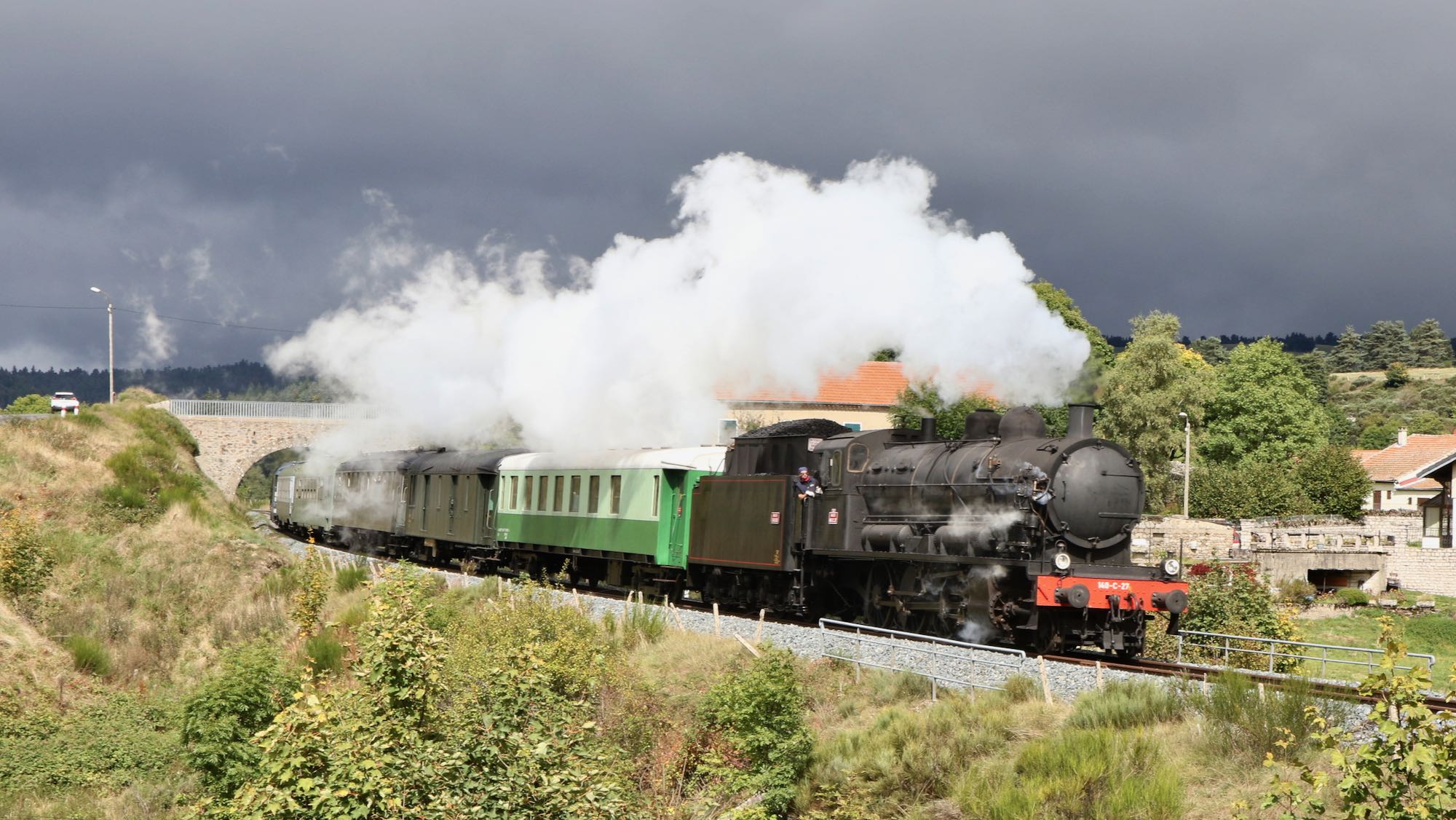
On Saturday 28th September 140 C 27 returned to its base at Nîmes having spent 2023 based at Le Creusot and this summer at Clermont-Ferrand. Travelling south along the Ligne de Cévennes, it is seen in a brief ray of sunshine between Langogne and La Bastide-Saint-Laurent-les-Bains, almost at the summit of the gradient from the Allier Valley. Photo: Georges Turpin.
140 C 27 operated its last run of the season on 5th October with a trip from Nîmes to Génolhac. Having covered 2,500 miles this season it will now undergo winter maintenace. This year the axles will be dropped and the driving wheels re-tyred. The notaries of the Gard département, who sponsor the locomotive by donating a euro for every transfer of title made, will meet €63,000 of the €80,000 cost.
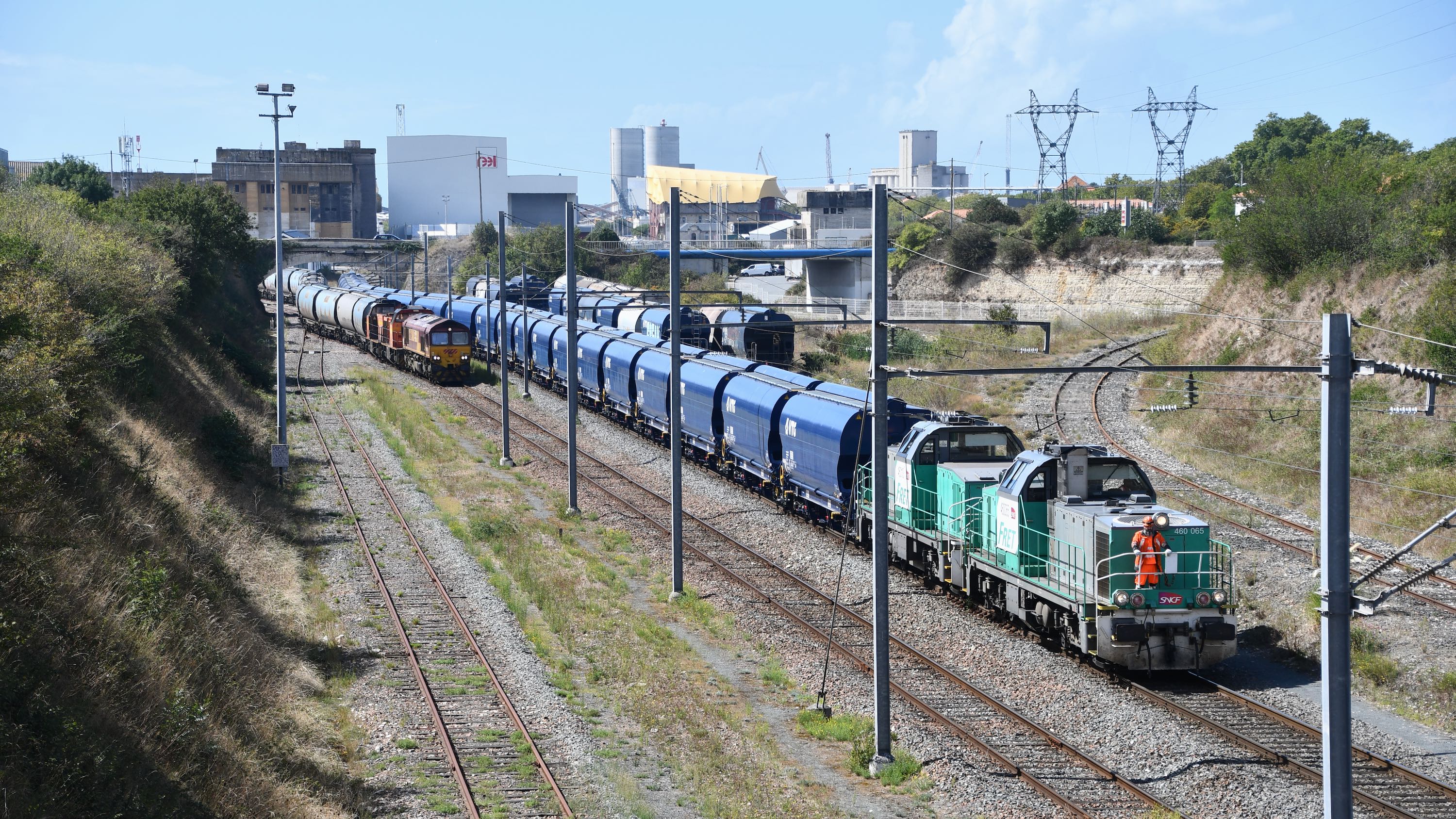
La Rochelle grain
La Rochelle’s port La Pallice is France’s second-biggest grain export outlet after Rouen, with 3 million tonnes handled in 2023. Almost all comes by rail, eight trains or more daily in season, though 2023 saw a decline in tonnage due to export of cheap embargo-busting Russian wheat to countries traditionally supplied from La Rochelle. Poor yield and a reduction in planting has led to a 26% drop in production this year, with a forecast total just short of 26 million tonnes.
The first 2.5km of the port branch from La Rochelle Ville also carries passenger trains to Porte-Dauphine, reopened in 2008 to serve the city’s administrative offices, schools and leisure facilities. A local service to Rochefort was re-established with several reopened halts south of the city. Though the 7km into the port area was electrified in 1993, the platform at Porte-Dauphine was not wired in the 2008 upgrade and MUs run on diesel traction. There are 14 daily trains, mostly in peak hours, running through beyond Rochefort to Saintes, Angoulême or Bordeaux.
Opposite. At La Rochelle-Porte-Dauphine on 19th September, Régiolis B 84647/48 enters the unwired platform to form TER 864625 16.48 to Angoulême. Photo: John Bamforth.
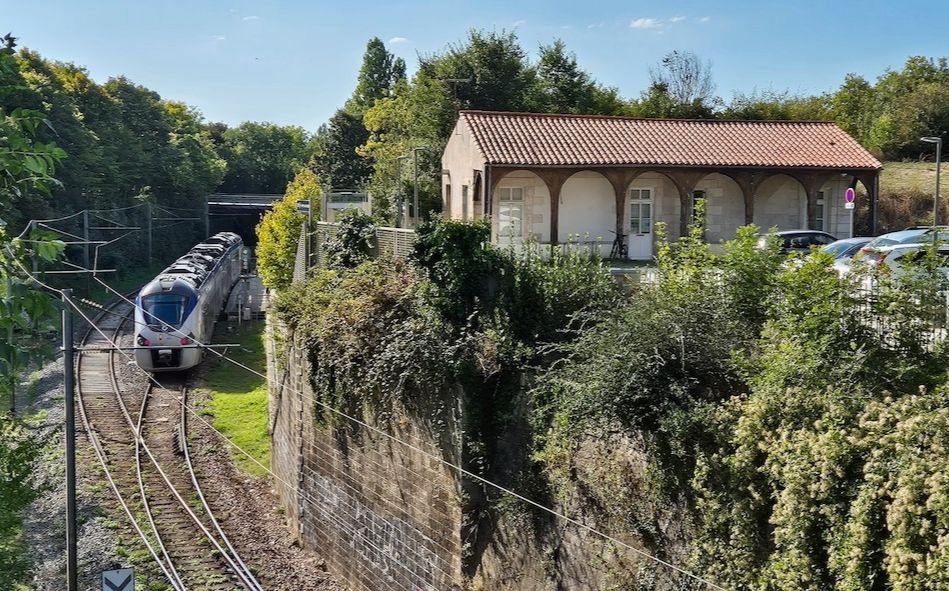
Use of electric traction on freight has declined; cereal trains are mostly diesel-hauled under the wires from and to Saint-Pierre-des-Corps, used by both Millet Rail and SNCF Fret as a staging post between the numerous cereal silos in Centre-Val de Loire région and La Rochelle. The majority of trains are now operated by Millet Rail using Class 66s and Vossloh G1206s.
Top. In the record 2022 season, Fret SNCF Nos 60065 and 60113 are seen in the port just west of La Pallice yard on 8th September, shunting VTG cereal hoppers while Millet Rail Class 66 No 66064 (on hire from DB Cargo France) plus G1206s 03 and 24 stand ready with Train 70045 14.40 La Pallice to Saint-Pierre-des-Corps. This is a double train of empties, a total of 44 covered hoppers. G1206 03 is owned by Beacon Rail but subhired by Millet Rail from Colas Rail, while 24 is directly hired by Millet from Colas Rail. A Sybic was seen in La Pallice yard that day, so some electric haulage continues.
Below. Later, at La Rochelle Ville, Millet Rail No 66236 (hired from DB ) plus another Class 66 (dead) were heading a double train of empties, 70035 20.24 La Pallice to Saint-Pierre-des-Corps, closely followed by Train 70037 20.40 empties (not a double rake) also to Saint-Pierre-des-Corps. Photos: David Haydock.

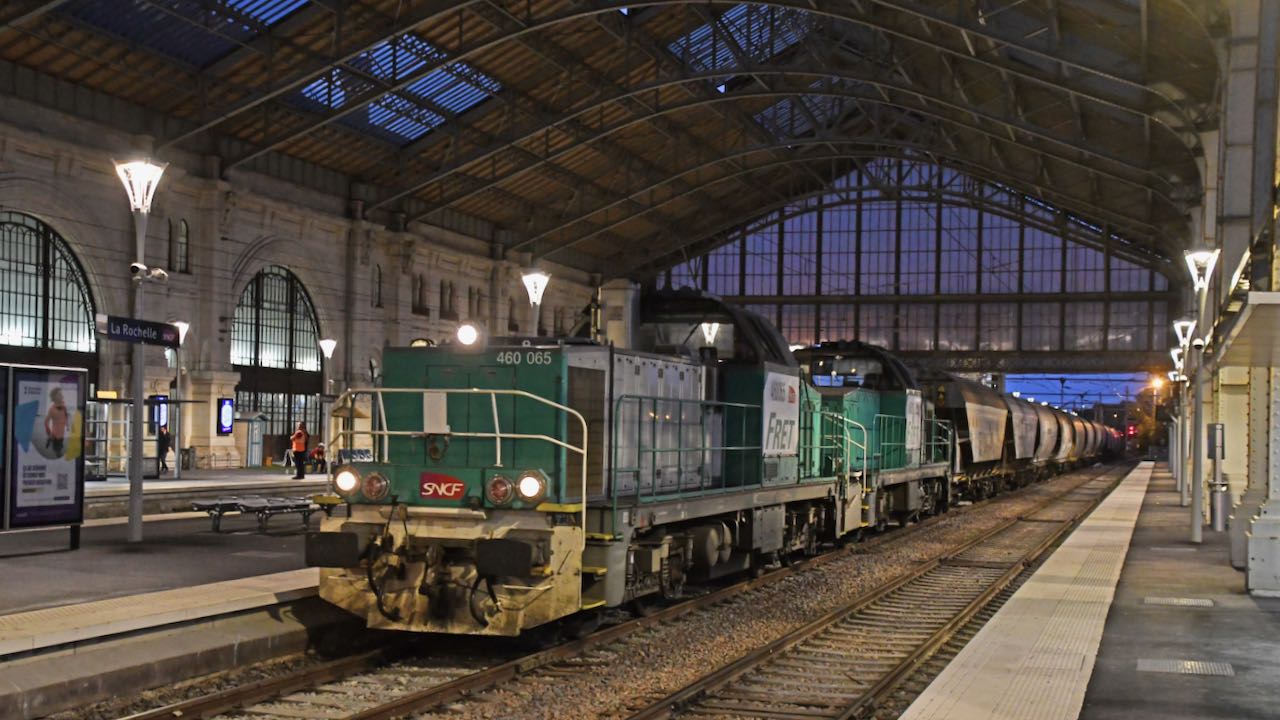
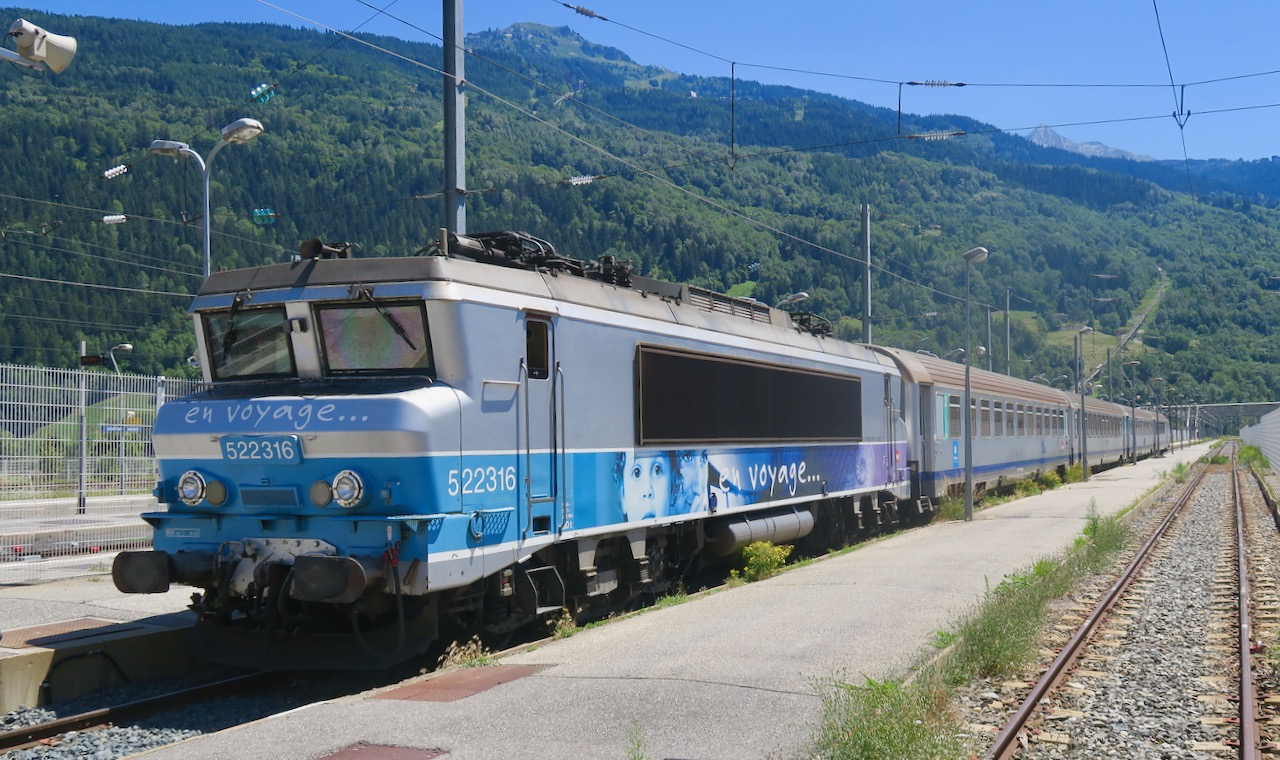
BB 22316 and an AURA TER Corail push-pull set are stabled at Bourg-Saint-Maurice during industrial action in July 2022
AURA rail audit
AURA (Auvergne-Rhône-Alpes) région faces a funding gap of €3.8 billion for the years to 2035 if the rolling stock fleet is to be modernised and expanded to meet the high standards expected by today’s travellers. This is the view of the chambre régionale de comptes in a report commissioned by AURA’s former president Laurent Wauquiez in 2022 which was published on 5th September.
“I’m afraid there are difficult years ahead” the chamber’s president Bernard Lejeune said at a press conference in Lyon. AURA’s network is the largest outside Île-de-France, carrying 220,000 passenger daily. Growth in passenger-journeys since 2017 has not been accompanied by a commensurate increase in rolling stock, described as ‘one of oldest fleets in France’, leading to overcrowding and cancellations on a daily basis. During 2023, 20% of trains were more than 5min late and 9% were terminated short of destination or cancelled, the Lyon – Villefranche-sur-Saône – Mâcon route being the worst performer with 18% of trains late or cancelled. The report highlighted the divergence between SNCF’s passenger satisfaction figures and those from independent surveys. SNCF’s figure of 87% was described as ‘biased’ because passengers on cancelled trains were excluded, whereas a survey of all passengers carried out for the CRC showed only 53% satisfied with their journey.
Like-for-like rolling stock replacement would not be sufficient to improve the quality of service, Lejeune said. Maintenance problems, particularly with the fleet of 215 elderly Corail coaches and their 34 BB 22200s dating from 1978-86, meant that most days the région was 30 trains short of what was required for the timetabled service. Maintenance deficiencies were compounded by poorly-sited depots that are too small for efficient throughput, with outdated infrastructure and equipment.
The report recommends that AURA should proceed with plans to take over the rolling stock fleet and responsibility for its maintenance, and reiterates the need to work with the State to secure funding for new trains and infrastructure modernisation. Opposition politicians had criticised the administration for not acting swiftly enough in ordering new rolling stock when it was so urgently needed.
The new president, Fabrice Pannekoucke, defended his predecessor’s record and confirmed the spending target of €235 million a year through to 2035 set out in last year’s budget. Nevertheless, this fell short of the €5.7 billion investment needed to modernise the network. He pointed out that another overcrowded route, Lyon – Vienne – Valence, is benefiting from introduction in September of 10 Regio 2N sets from an order for 19 placed in 2020, providing extra capacity on 52 daily trains. Planned orders for a further 130 R2N sets or other stock to replace the Corail fleet have yet to be confirmed.
On 10th October, AURA officials approved the establishment of a special-purpose vehicle to handle future rolling stock purchases. The new entity, to be owned 80% by the région and 20% by Vichy Communauté, will simplify purchasing as services are opened to competition and allow debt to be issued without appearing on the région’s balance sheet.
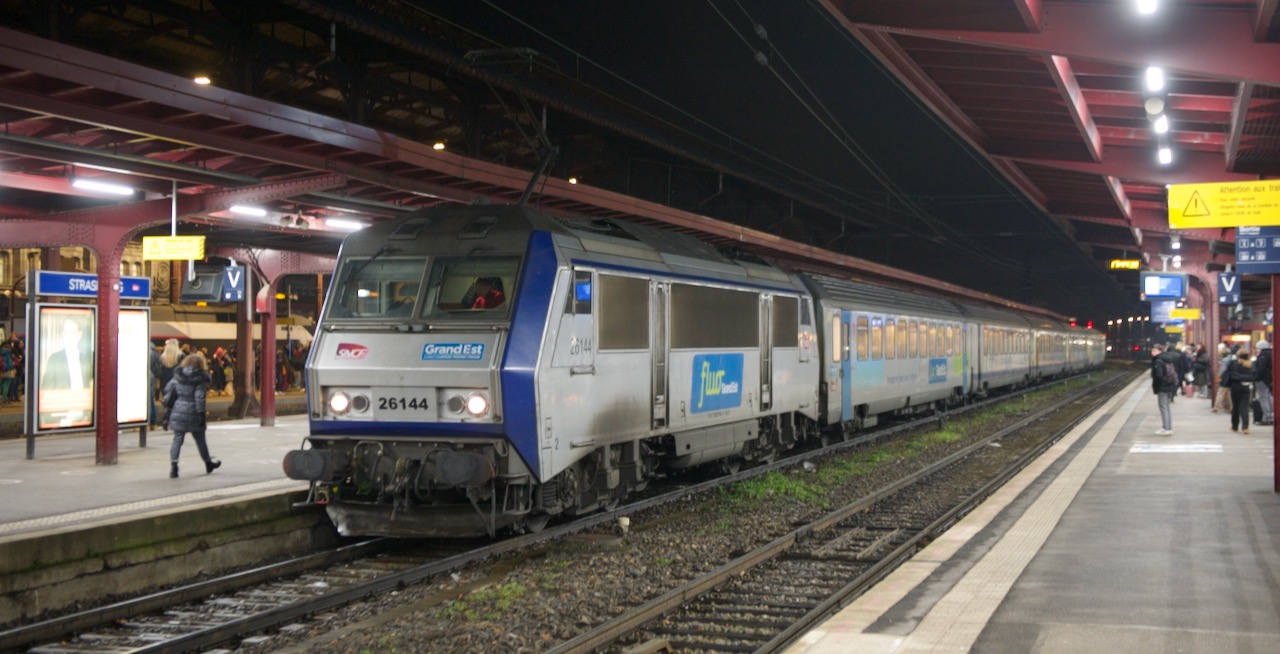
Grand Est TER 200 replacement sought
Grand Est région has published a call for Expressions of Interest in supply of rolling stock to replace its 200 km/h push-pull trains consisting of 1980s Corail coaches powered by BB 26000 Sybic locomotives. The current fleet of around 150 coaches, in rakes of between five and eight hauled by 22 BB 26000s, is to be replaced by new push-pull trains or EMUs by 2032. They will be used mainly on the Strasbourg – Basle TER 200 service, though GE also uses BB 26000 and Corail stock of similar vintage on routes from Strasbourg to Metz, Nancy and Paris Est. As well as running under 25 kV AC 50 Hz in France, the trains will need to be equipped to operate at 15 kV AC 16.7 Hz in Switzerland as Basle SBB station is to lose its current commutable 15/25 kV OHL equipment from 2032.
Following the initial EoI phase, tenders will need to be submitted by 1st October 2025, whilst the contract will be announced in December 2027. One obvious candidate for the contract is CAF’s Oxygène 200 km/h EMU which is currently being produced at Reichshoffen (in the Grand Est region) for SNCF’s Intercités services from Paris to Toulouse and Clermont-Ferrand.
Above. BB 26144 waits to depart from Strasbourg on the 4th December 2023 with the 17.49 to Metz on one of the shorter six coach rakes normally employed on the Paris, Metz and Nancy services. As with the AURA push-pull Corail services, reliability is an issue, and it is difficult to imagine them hurtling between Strasbourg and Basle at 200km/h for another eight years.

Z 26505/06 seen at Nice on 26th September is the first of Région Sud's TER2N NG fleet returned to service following mid-life overhaul that includes equipping with ERTMS. The mi-vie programme includes replacement of traction motors and other major components and is intended to extend working life by 15 to 20 years. Repainting in Région Sud's Zou! livery consumes 650 litres of paint.
Région Sud operates 15 TER2N NG units on the Grasse – Nice – Ventimiglia axis, of which five are owned by the Principality of Monaco.
Photo: Georges Turpin.
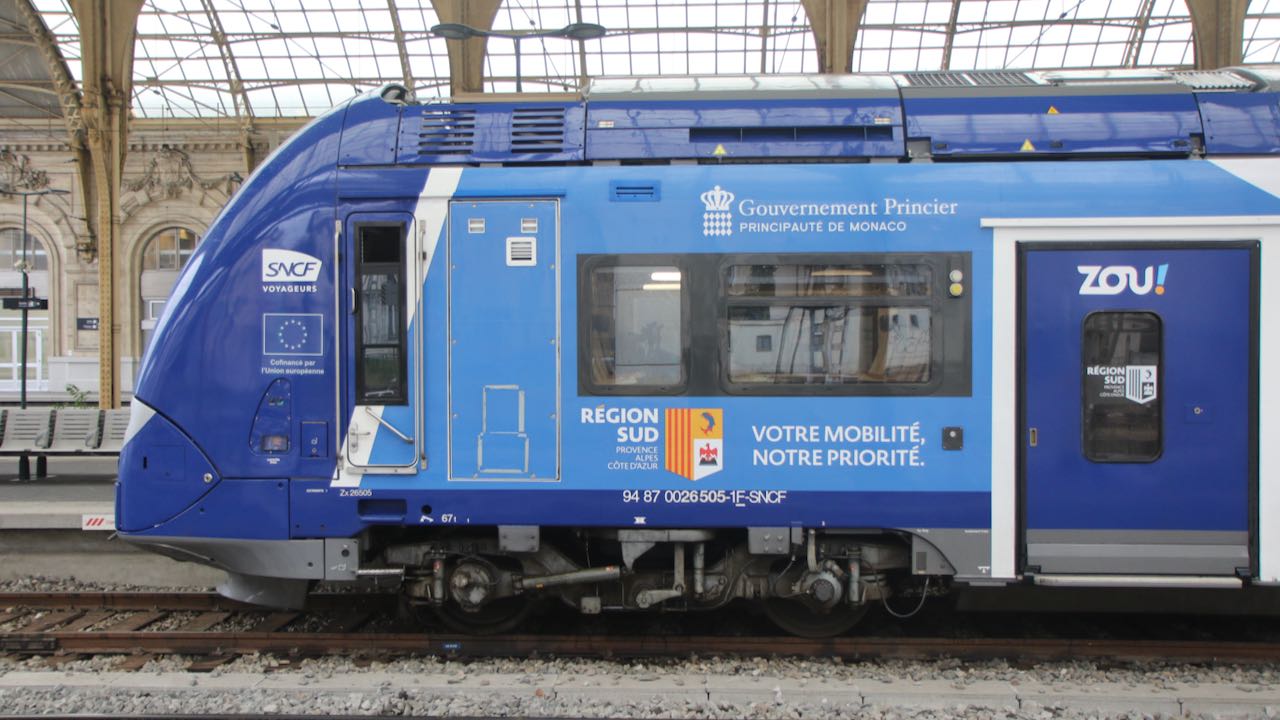

Proxima orders Alstom Avelia Horizon TGVs
Proxima plans to operate services between Bordeaux, Nantes, Rennes, Angers and Paris, to some extent covering the same area as planned by Le Train. The agreement with Alstom covers maintenance for 15 years at the depot being developed by Sud Europe Atlantique LGV concessionaire Lisea at Marcheprime south of Bordeaux (see November 2023 News). The depot is part of Lisea's effort to encourage other operators to use the LGV by meeting one of the main barriers faced by independent operators.
Unlike the other start-ups, Proxima entered the market with finance already in place. Proxima is backed by Antin Infrastructure Partners which is providing up to €1.2 billion for the rolling stock, start-up costs and working capital. Of the others, Railcoop has been wound up and Midnight Trains has abandoned its plans. Le Train has selected Talgo for rolling stock, but both it and Kevin Speed are still seeking financial backers.
Eckwersheim verdict
Judgement was handed down at the Paris criminal court on 10th October in the trial of those responsible for operating the TGV Est test train that crashed at Eckwersheim near Strasbourg on 14th November 2015, killing 11 people and injuring 42. Three corporate entities, SNCF, SNCF Réseau and Systra (organiser of the tests), were found guilty of ‘involuntary homicides and injuries [caused] by incompetence, recklessness, negligence or breach of a safety obligation’, as were the train manager and driver. A third individual, a Systra employee who was in the cab, was cleared.
The accident occurred during over-speed trials prior to opening of LGV Est. Instrumented TGV 2N2 EuroDuplex Set 744 left the tracks at high speed on a curve, overturning and striking the parapet of a bridge over the Marne-Rhine canal. The train was travelling at 352km/h and failed to brake as required before the sharp curve leading to the junction with the classic line. There were around 50 people on board including 28 unauthorised ‘guests’ who were family and friends of the test team.
All the defendants had initially denied responsibility, but at the trial in April SNCF conceded a degree of culpability; it was fined €400,000. Systra was fined €225,000, the legal maximum for ‘multiple incidences of negligence and poor staff training’; and SNCF Réseau €150,000. The train manager received a 15-month suspended prison sentence, and the driver seven months suspended.
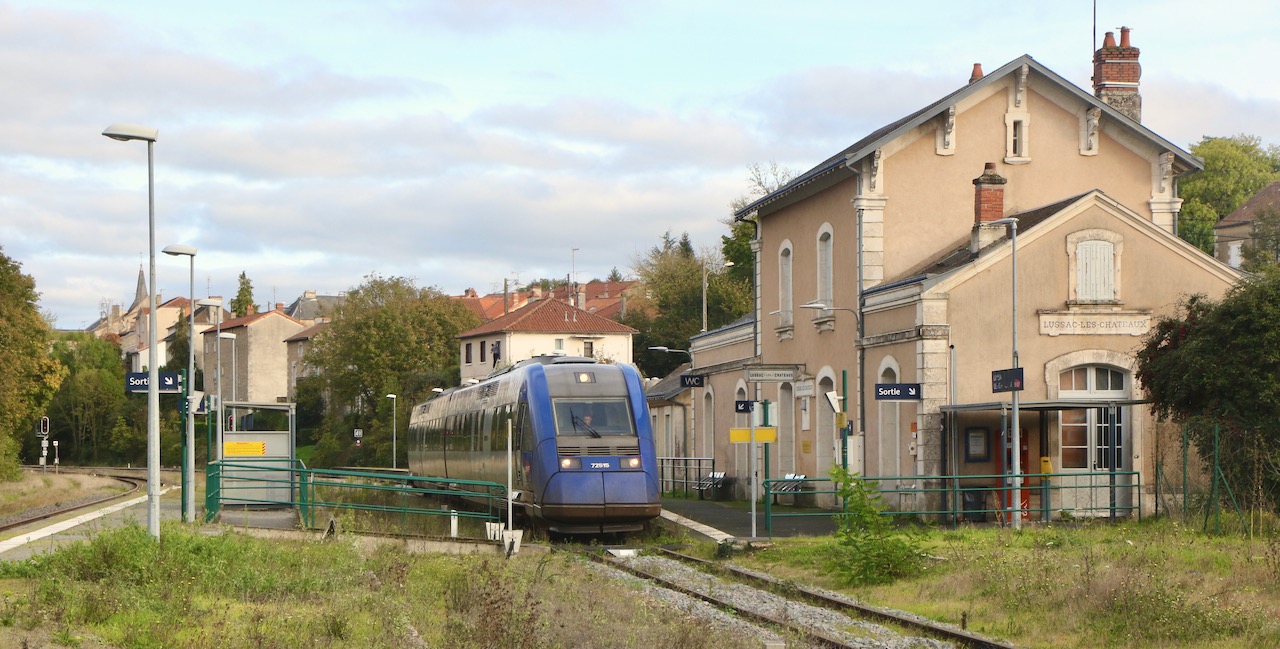
Limoges – Poitiers TER 868010 calls at Lussac-les-Châteaux on 25th October 2019 formed of X 72515/16. In that year the station saw 23,000 passengers. After a decline during covid, patronage grew to almost 30,000 in 2023 and has been further encouraged this year by new short workings between Poitiers and Montmorillon. Photo: Georges Turpin.
Poitiers – Limoges upgrade
One of Nouvelle-Aquitaine’s biggest renovation projects starts on 2nd December when the northern section of the Poitiers – Limoges line will be closed for 11 months. The 83km between Poitiers and Le Dorat is to be rebuilt at a cost of €70 million, 52% financed by the région. The objective is to raise line speed to 140km/h, eliminating a lengthy 40km/h slack between Mignaloux-Nouaillé and Lussac-les-Châteaux and a 30km/h restriction in a cutting at Montmorillon. Journey time will be cut by 10min to around 40min for the 600 daily Poitiers – Montmorillon passengers. The improvements will also allow continued operation of cereal trains between Montmorillon and Poitiers (50 trains/year) and over the 13km branch from Mignaloux to Jardres (40 trains/year). There are also about 10 trains/year of fertiliser from the MEAC plant at Lussac.
The section from Le Dorat to Limoges (56km) will be upgraded in a second phase starting late next year. Despite remedial work carried out in 2018, this portion of the route also suffers from speed restrictions as low as 40km/h due to sharp curvature and poor track. On completion in 2027, the service will be increased from eight to 10 A/R daily and new trains introduced from the batch of 18 to be ordered through SPIIT for delivery in 2026.
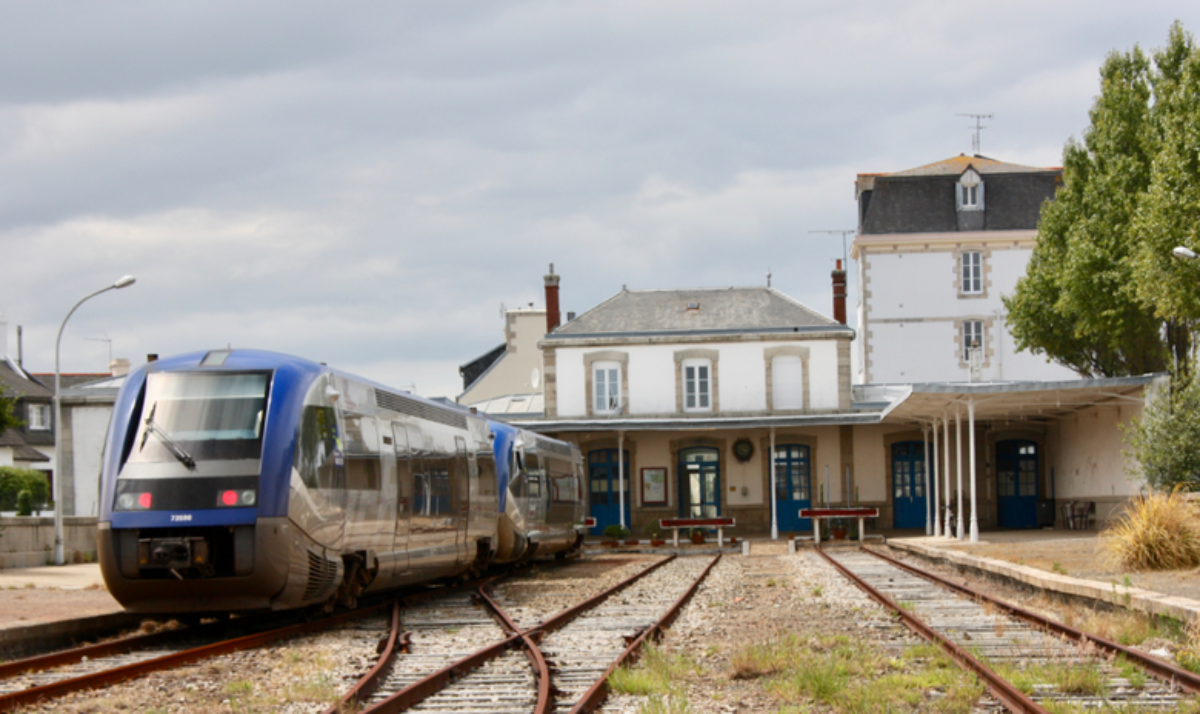
Bretagne reopenings studied
At a ceremony on 13th September to officially inaugurate the renovated line between Dinan and Lamballe (see August News), Bretagne president Loig Chesnais-Girard promised continued support for the région’s minor lines. In the next 12 months work will begin on renewing the 53km Guingamp – Carhaix passenger line and the 56km Auray – Pontivy – Saint-Gérand freight route.
A few days later, the région published a study proposing several options for reuse of the line from Morlaix to Roscoff (28km), closed in 2018 due to flood damage. Reconstruction is estimated at €79 million, slightly less if freight traffic is excluded. This would equip the line to accommodate existing TER rolling stock or the TELLi lightweight railcar under development. Trades union members of the local action group expressed surprise at the €3 million/km cost when compared with the €1 million/km usually considered as the base cost of relaying, though restoration of flood-damaged infrastructure is likely to be expensive.
Other options assessed included conversion to a voie verte (€20 million) and use of part of the route for tourist trains (€10 million). Both were considered poor value for money. Local groups favour the line’s use for both public service and tourist trains, but no local businesses have expressed interest in using the line for freight. The région has made no recommendation and a decision is unlikely in the short term.
Further studies will look at reopening the 114km Saint-Brieuc – Loudéac – Pontivy – Auray line for passengers, and the 36km between Vitré and Fougères (closed to passengers in 1972). A 7.5km section of this line, rebuilt in 2021, remains open at the Vitré end as far as Gérard carrying cereals to the Cooperl agricultural co-operative and its livestock-feed factory at nearby Montreuil-sous-Pérouse.
Meanwhile, Rennes Métropole has approved a €1 million study into the Liaison Nouvelles Ouest Bretagne Pays de la Loire proposal for improving links from Brest and Quimper to Rennes and Nantes, and a new line from Lamballe to Rennes to cut Paris journey time to 3h. Implementation is planned for the years 2035 to 2050.
Above. Single cars X 73590/73605 at Roscoff on 9th July 2011 after arrival from Morlaix. Photo: Railwayworld.net/Gareth David.
Hauts-de-France SERM consultation
Centred upon Lille, the SERM will see existing routes to Hazebrouck, Bethune, Douai, Valenciennes, Lens and Kortrijk in Belgium upgraded to offer service every 5-10min, with a new route from the centre of Lille to Lesquin airport and Hénin-Beaumont. New stations would be opened in the centre of Lille and at Lesquin (airport) with the option of reopening some former stations. Long-distance routes to Calais, Amiens, Dunkerque, Hirson, Maubeuge and Saint-Quentin will see services every 15-30min.
The proposal has its origins in a 2015 plan by Nord-Pas-de-Calais région to expand TER services in the Lille area. Following creation of Hauts-de-France région in 2016, the plan was shelved due to a change of political priorities, but has now been resurrected and forms the basis of the proposed SERM.
The two major elements, creation of a new underground through station in Lille (to relieve pressure on Lille Flandres) and a new 35km line from Lille via Villeneuve d’Ascq and Seclin to Hénin-Beaumont with a branch to Douai, will cost € billions, making this the most expensive SERM project.
Other parts of the plan could be achieved relatively quickly and at a modest cost: reopening to passenger traffic the 9km Ceinture freight line from Lambersart to Haubourdin with the section of the Béthune – Lille passenger line from Haubourdin to Porte de Douai and a freight chord from Porte de Douai to Lesquin; creating new stopping services via Lille Sud (serving the city’s CHR teaching hospital complex); and reopening stations such as Lomme (interchange with metro).
Other elements of the plan to support the increased train frequency by seeking to improve access to stations by foot, bicycle, car-pooling and other public transport should also be relatively easy to implement.
Other parts of the plan could be achieved relatively quickly and at a modest cost: reopening to passenger traffic the 9km Ceinture freight line from Lambersart to Haubourdin with the section of the Béthune – Lille passenger line from Haubourdin to Porte de Douai and a freight chord from Porte de Douai to Lesquin; creating new stopping services via Lille Sud (serving the city’s CHR teaching hospital complex); and reopening stations such as Lomme (interchange with metro).
Other elements of the plan to support the increased train frequency by seeking to improve access to stations by foot, bicycle, car-pooling and other public transport should also be relatively easy to implement.
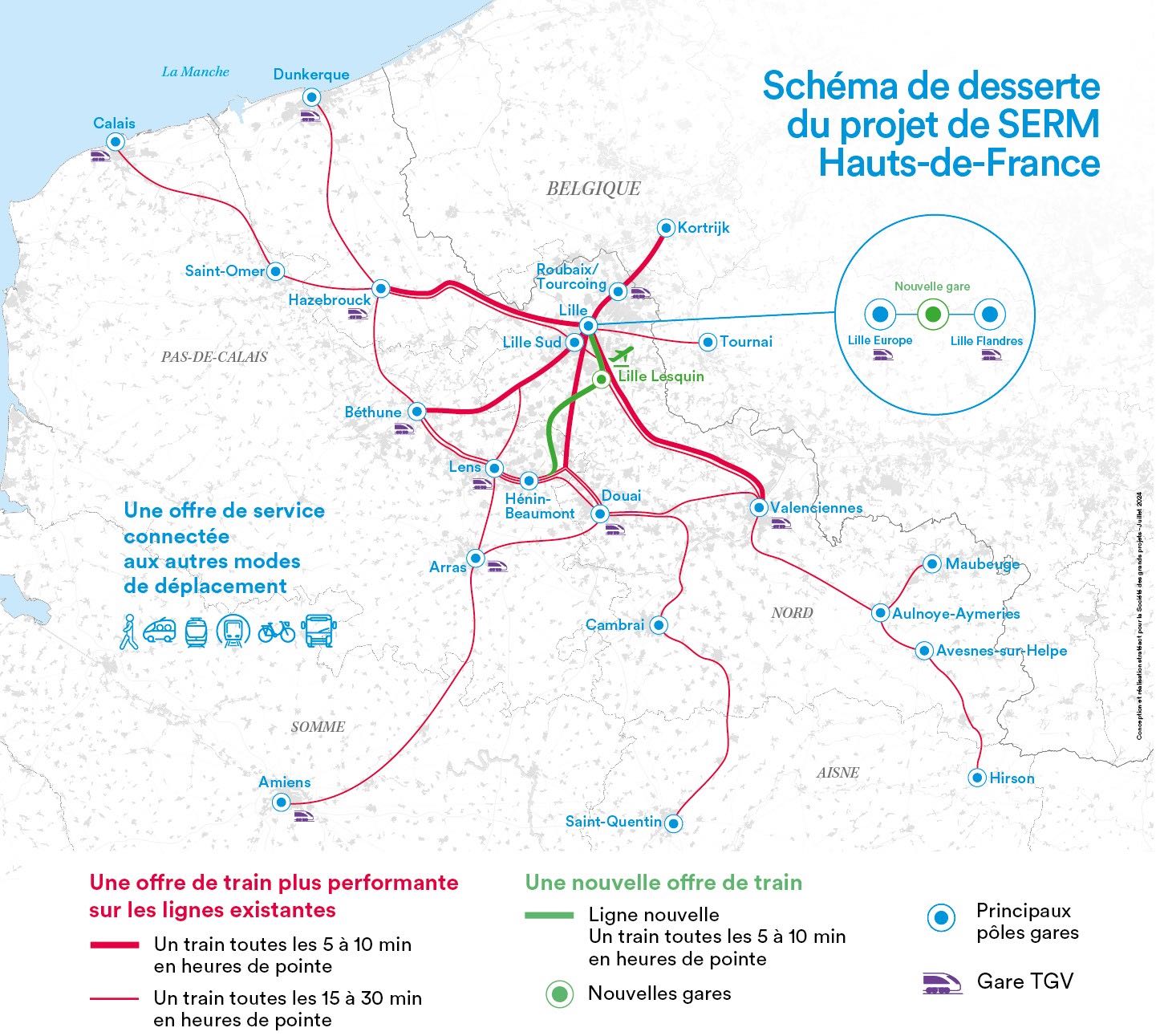
Weather report
Storms Kirk and Leslie swept across France in the first and second weeks of October leaving a trail of damage. On the 8/9th a landslide closed the line between Meaux and Trilport east of Paris, cutting Transilien Line P services to Château-Thierry and La Ferté-Milon and TERs to Épernay and Châlons-en-Champagne. Some 5,000m3 of earth threatened to fall onto the track, restrained initially by placement of 80 sandbags each weighing 1.5tonnes. Remedial work took nearly three weeks to complete with services resuming on the 28th October.
Opposite. Sandbags protecting the track from the landslide on Line P as work is undertaken to stabilise the cutting.
Photo: ©SNCF Réseau
Photo: ©SNCF Réseau
Another landslide affected trains at Saint-Cyr near Versailles and services around Strasbourg were delayed by fallen trees and washouts. Along the Atlantic coast, lines from Royan south to Hendaye were closed on the 9th until 20.00 for safety reasons. On the 15th a landslide at Rochefort-sur-Nenon led to a fortnight of single-line operation with diversions and cancellations between Dole and Besançon while repairs were carried out.
Storm Leslie caused more damage and flooding, with many lines closed again as a safety precaution. No trains ran between Alès and Mende/Langogne on the 16th and 17th; most routes out of Toulouse were closed until the 18th with no alternative service offered, as were lines in the Dordogne and Périgord. On the 25th, TER 873994 17.01 Nîmes to Clermont-Ferrand formed of AGC X 76725/26 derailed at Saint-André Capcèze just south of Villefort after hitting a fallen tree. The driver and one passenger were slightly injured; service was expected to resume on the 31st.
Saint-Étienne – Lyon was closed on the 8th after a month’s worth of rain fell in one day causing a washout at the viaduc de Voron at Saint-Chamand. The following week on the 17th service was interrupted again after flooding at Givors, the closure expected to last three weeks.
Storm Leslie caused more damage and flooding, with many lines closed again as a safety precaution. No trains ran between Alès and Mende/Langogne on the 16th and 17th; most routes out of Toulouse were closed until the 18th with no alternative service offered, as were lines in the Dordogne and Périgord. On the 25th, TER 873994 17.01 Nîmes to Clermont-Ferrand formed of AGC X 76725/26 derailed at Saint-André Capcèze just south of Villefort after hitting a fallen tree. The driver and one passenger were slightly injured; service was expected to resume on the 31st.
Saint-Étienne – Lyon was closed on the 8th after a month’s worth of rain fell in one day causing a washout at the viaduc de Voron at Saint-Chamand. The following week on the 17th service was interrupted again after flooding at Givors, the closure expected to last three weeks.
Buses ran between Saint-Étienne and Givors, though only during peak hours, SNCF taking five days to arrange a substitute service on this route used by 25,000 passengers daily. Photo: Le Progrès/FP.
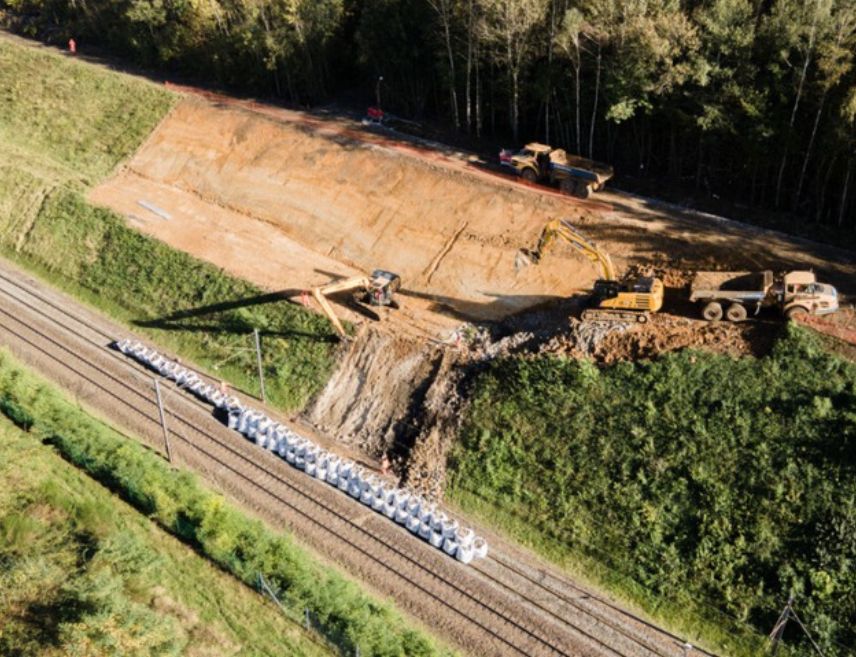

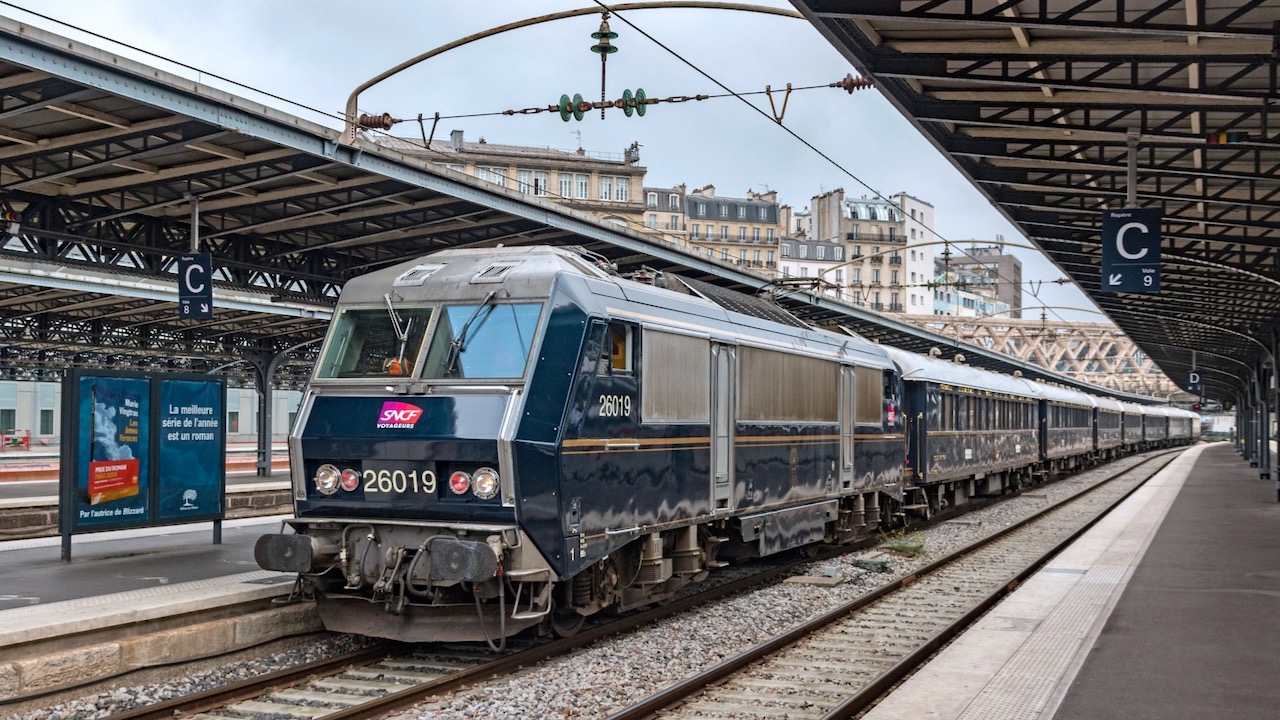
Trains Spéciaux de SNCF Voyageurs have repainted two class 26000 Sybics (26005/26019) in a lined dark blue livery for working with CIWL stock. On 29th October BB 26019 is seen at Gare de l'Est with the VSOE, that later departed for Venice behind BB 26005. Photo: Christophe Masse.
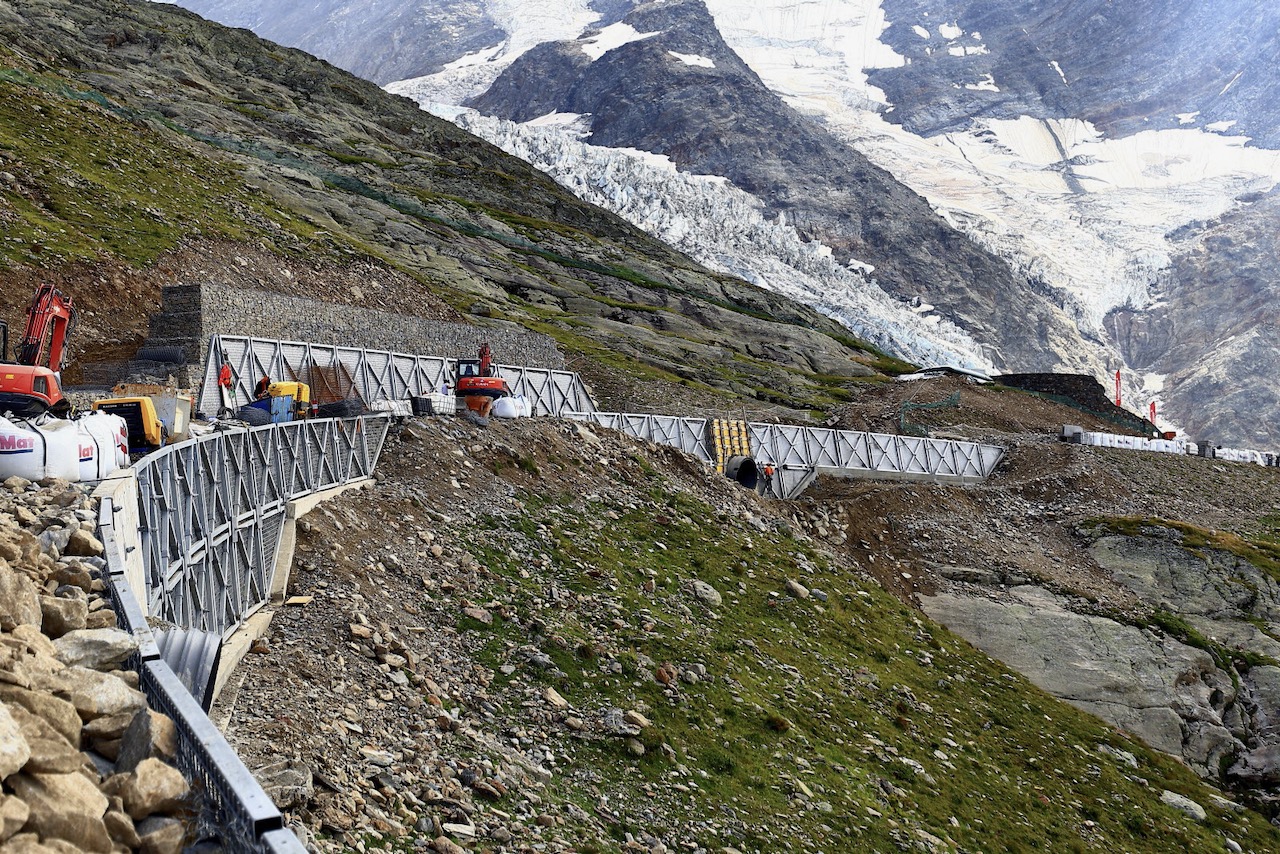
Le Tramway du Mont-Blanc progress
Progress has been made over the summer on the €120 million completion of Le Tramway du Mont-Blanc that will extend it a further 300m to a flat terminus at the Nid d’Aigle refuge. Construction was suspended at the outbreak of World War One, and for the last 110 years the tramway has used a steep temporary terminus. Above shows the position at the end of August looking up towards Nid d'Aigle with new barriers, bridges and retaining walls. Photo: Le Dauphiné Liberé /Greg Yetchmeniza.
The same view looking in the opposite direction (right), taken in July 2022, shows in the distance the line emerging from the tunnel and terminating on a steep incline with limited space and facilities. Climbing up from the station from left to right is the rough, uneven track that linked the terminus with the refuge and cafe at Nid d'Aigle.

News in Brief

RENFE losing patience. "It is clear that France is doing everything possible to prevent a genuine process of liberalisation in its market”, Spanish transport minister Oscar Puente said last month in an interview with El Pais. He was sceptical that RENFE trains would be cleared to run through to Paris by December, or even during 2025. On the other hand, RENFE will introduce a daily return service between Barcelona and Toulouse next April with stops at Carcassonne, Perpignan, Figueres and Girona and journey time of around 3h 30. Initially running summer only, RENFE hopes to offer year-round service timed to suit business as well as leisure travellers.
In contrast SNCF's domestic services in Spain appear to be operating well, although apparently at a financial loss. Above. On Friday 4th October a pair of Euroduplex with set 809 leading head away from Lérida with Ouigo España 6540 13.50 Barcelona Sants – Madrid Atocha. The track beyond the train is the Spanish gauge line from Lérida to Zaragoza. Euroduplex 809 is part of the batch (807-819) with Spanish ERTMS - ASFA signalling equipment which are no longer able to operate in France. Photo: Georges Turpin.
Corse. The entire network was closed for two weeks from 19th October for testing and commissioning of CTC commande centralisée de voie unique being installed by SITEC under a €22 million contract. New passing loops have been built at Algajola and Lumio on the Calvi line, with two projected for Purettone (Borgo) and Les Cannes. For implementation of the Bastia suburban project (see October News) it is now planned to order 14 tram-trains, though no timescale has been announced. These would be sufficient to operate the proposed extension to Bastia airport should that go ahead, and would allow the 12 AMG800 DMUs (CFD 2007-13) to be concentrated on long-distance services.
Marseille – Nice. Transdev Rail Sud Inter-Métropoles was established by Transdev in September to operate the Marseille – Toulon – Nice service it will take over from SNCF next June. Asked last month about delays in delivering the 16 Omneo Premium EMUs on order for the service, Alstom said its current expectation was for seven trains to be available by the end of June 2025. Transdev said it was doing everything possible to deliver the planned service, even if it meant using ‘alternative rolling stock’
Transdev. Caisse des Dépôts is looking to divest part of its majority shareholding. It will test the market for disposal of half or more on its 66% holding, which would effectively lead to privatisation.
PACA. SNCF held a trial run on 26th September for the 15min interval service to be introduced between Cannes, Nice and Menton with the December timetable change. Fifty new drivers have been trained..
Lacanau. Agence d’urbanisme Bordeaux Aquitaine has been awarded a contract to study the feasibility of re-establishing a rail link between Bordeaux and the resort of Lacanau.
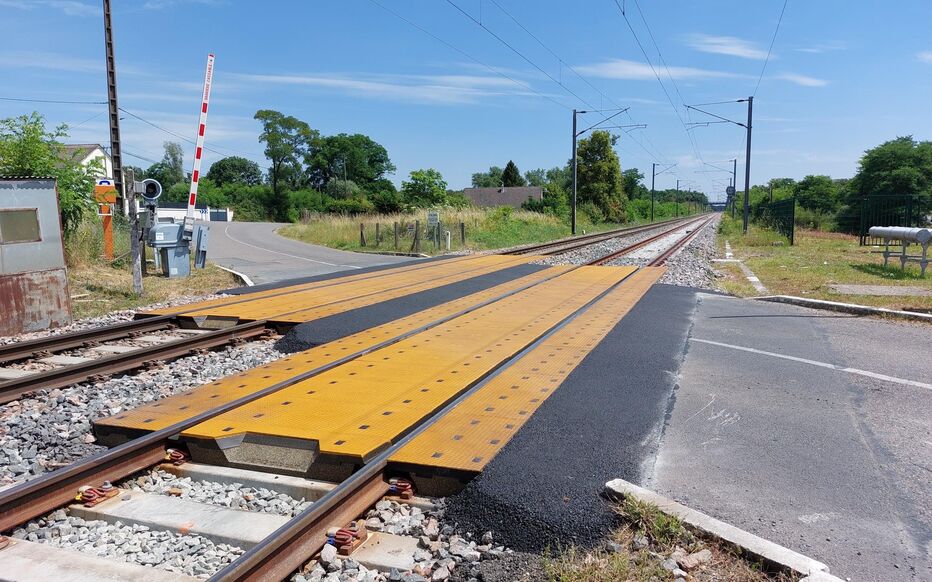
Crossing safety. SNCF is experimenting with coloured surfaces in an attempt to make road-vehicle drivers more cautious at level crossings. Yellow panels were installed this summer at Gien on the Paris – Clermont-Ferrand line where there were two fatalities in 2022. Photo: SNCF Réseau.
Amberieu. Operation of the 12km branch into the Pipa industrial park east of Lyon has been abandoned by SNCF. Pipa’s owner has been trying for years to increase traffic but only a handful of the 180 firms based there use rail. The remaining activity and maintenance of the line, which is owned by Pipa, will be handled by contractor Sferis.
Paris Saint-Lazare. Consultation is taking place on the proposed flyover at the approach to Saint-Lazare which would eliminate conflicting movements between Transilien Line J and trains from Normandie when accessing the longer platforms on the east side of the station. Construction would take up to four years for completion by 2032 and cost €250 million.
GPSO. A public enquiry has approved the start of full-scale construction south of Bordeaux, where work began on SNCF land at the beginning of the year. Four members of the new parliament and a senator have called for the project to be halted so that a referendum can take place in the 2,340 communes affected by the new local tax contribution demanded.
Guichets. Following protests at cuts, ticket office opening hours at eight major stations in Hauts-de-France have been extended from 09.00 – 17.00 to 06.00 – 20.00, though with only half the number of windows open despite a subvention of €3 million from the région to fund additional ticket office staff.
Blanc-Argent. In addition to the ongoing track upgrade, BA’s four X 74500 railcars (CFD Bagnères 2001/02) have undergone a mid-life technical overhaul, carried out at Romorantin by staff from SNCF’s Nevers Technicentre at a cost of €4.4 million. The fifth car, X 74503, remains out of use after an accident.

Night train concepts. Alstom and Future Travel Studio have unveiled designs for night train interiors. The DreamSuite is based on the flat beds installed in long-haul planes: a reclining seat that can be laid flat to make a 1.9m bed. With space for luggage and personal effects, the bed can be closed off by a screen for privacy, or with screens open makes a cabin for two. The modules can also be installed in existing coaches. Photo: Future Travel Studio.
Saint-Étienne. SNCF’s decision to close the TGV crew depot has given rise to fears that the city’s four daily Paris TGVs are to be withdrawn. Currently 12 TGV drivers are based here; from December, crews will be supplied from Lyon. SNCF denied any plan to cut the through service.
Quimperlé. A 7.5km section of voie verte opened last month between Moëlan-sur-Mer and Riec-sur-Bélon on the trackbed of the metre-gauge CF Départementaux du Finistère Quimperlé – Concarneau line closed in 1936.
TGV Atlantique. All TGVs serving Pays de la Loire, Le Mans, Angers and Nantes will be Océane sets from the December timetable change, the double-deck trains giving some 300,000 additional seats annually, while 85% of Paris – Bordeaux trains will be formed of two sets. A new TGV maintenance depot is to be built at Nantes by 2028 to reduce the workload at Paris Châtillon where 100 sets are currently based for the entire Atlantique service.
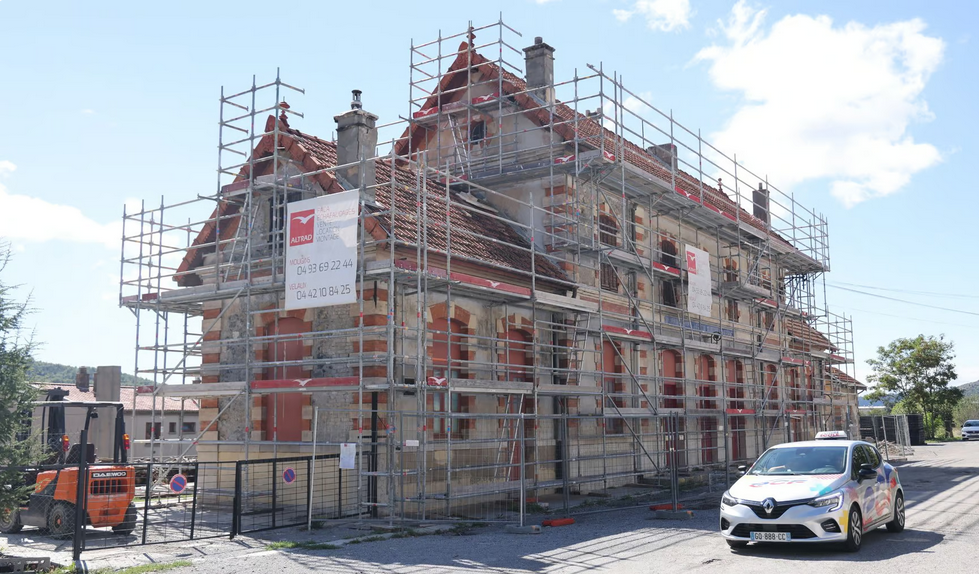
Digne. Renovation of the CP station building will be completed by the end of the year, part of the €6 million works being undertaken in readiness for reopening of the upper part of the line in 2026 (see August News).
Étoile de Veynes. PACA is promising €600 million for rail improvements in the new Contract-Plan starting in 2027, with the three routes to Veynes and Briançon prioritised to ready them for 2030 Winter Olympics traffic.
Tarbes ICN. Will serve two additional stops from 16th December, Biganos-Facture (dep 22.28, arr 05.48) and Saint-Vincent-de-Tyrosse (21.18/07.01). There will be same-platform interchange at Biganos for stations to and from Arcachon and Mont-de-Marsan.
Millau. TER Occitanie ran a €2 fare special Train 22400 from Béziers at 10.05 on 12th October with Z 27893/94 to bring visitors to Millau’s celebrations of the Ligne des Causses 150th anniversary; it returned at 18.35. Also at Millau, construction of a voie verte alongside the railway northwards to Aguessac (6km), approved by SNCF for opening in 2025, has been postponed again, along with the proposed reopening of Aguessac station.
Nîmes. TGV 6202 06.59 Perpignan – Paris came to a halt in open country on 13th October at Comps just east of Nîmes due to an electrical fault. With no functioning aircon or lighting, passengers were able to leave the train to refresh themselves with the help of sapeurs-pompiers from nearby Remoulins; the westbound line remained operational.
Two BB 79000s were sent from Marseille to rescue the train, one set of which was eventually restarted. The convoy moved to Nîmes-Pont-du-Gard station at 14.30 where another set was provided to take the passengers forward, reaching Paris around 6h late at 18.18. Photo: Gendarmerie du Gard.
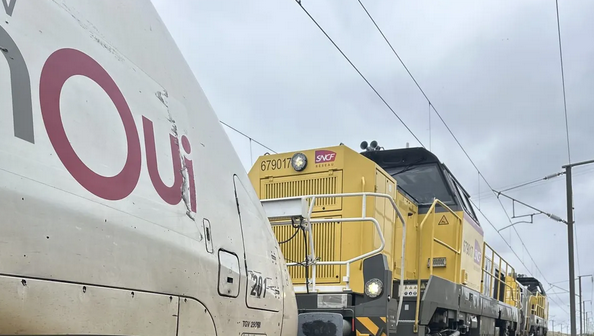
POLT 2025 works
Daytime Paris – Orléans trains will be suspended for nine months whilst the 37km three-track section between Boisseaux and Les Aubrais is renewed using a factory train. After a preparatory period starting in April 2025, the main work will see the line closed from 09.30 to 17.30 between August and January 2026 with a break over Christmas.
According to SNCF Réseau, this section must remain open overnight due to its heavy use by freight trains which cannot be diverted. Overnight work elsewhere means that the Toulouse night train will run weekends only, and that to Latour-de-Carol only during holiday periods.
Fears that budgetary pressures facing the new government would affect the upgrade were only partly allayed when AURA officials met the transport minister on 10th October. While he gave an assurance that the overall project was safe, he said there was likely to be a temporary funding shortfall in 2025.
On 24th July a scruffy BB 26017 heads along the three-track section at Tivernon south of Toury with TER 860511 12.40 Paris – Orléans. Photo: Georges Turpin.
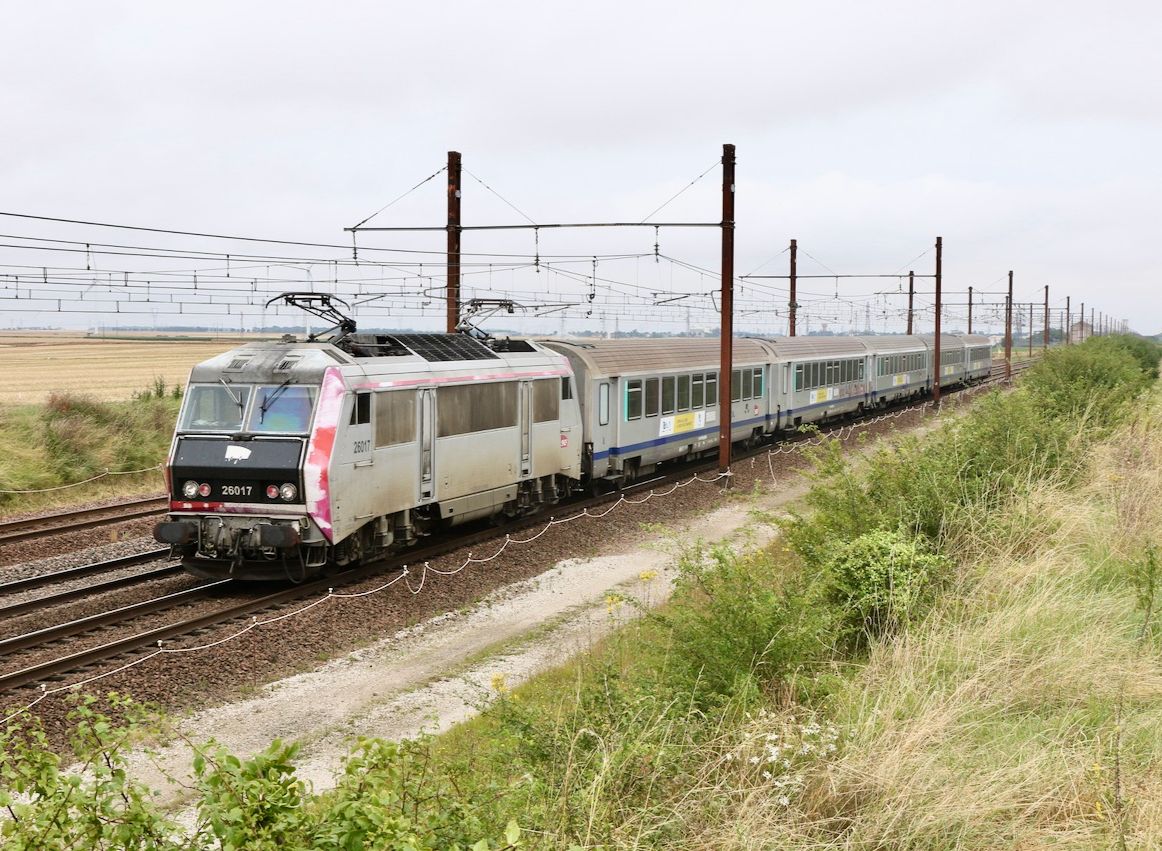
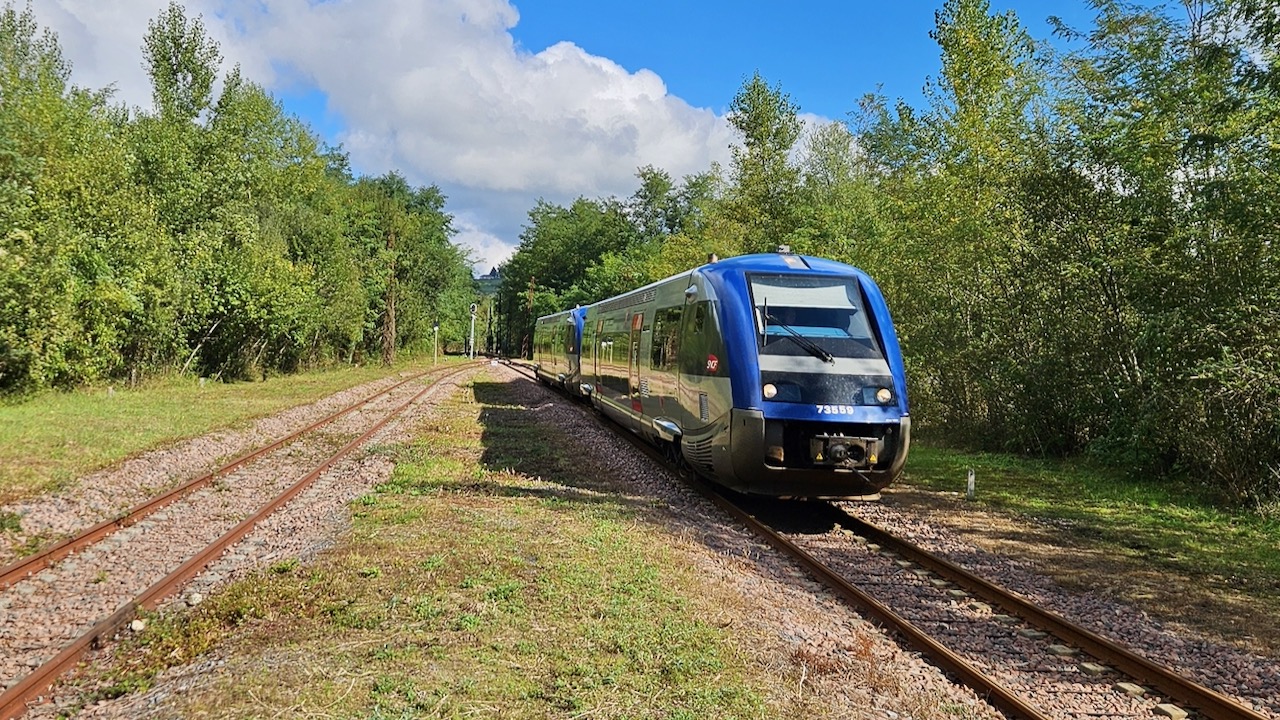
The loop at Buzy-en-Béarn, relaid in 2010 but currently unused, is to be extended to 450m to accommodate freight trains. On 4th October, X 73559/73732 arrive on TER 867423 12.00 Pau – Bedous. Buzy was the junction for the 19km line to Laruns-Eaux-Bonnes, closed to passengers in 1969 but open for freight as far as Arudy until 2003, the 6.5km section now a voie verte. Along with the Canfranc line, Laruns had been energised in the 1920s Midi electrification programme. De-electrified in 2008, Buzy should see electric trains again when the line reopens to Canfranc.
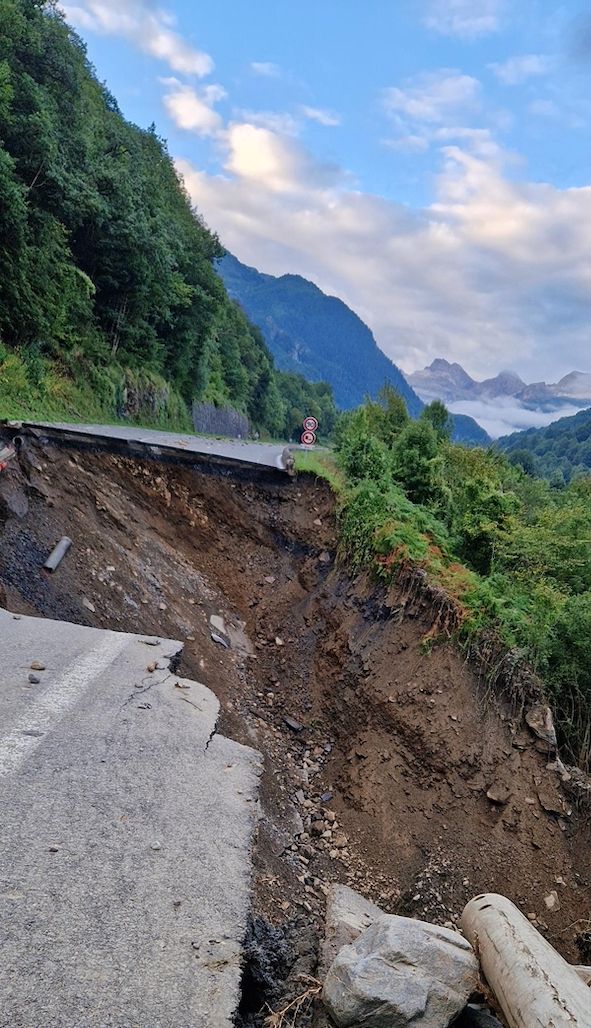
Canfranc: progress on both sides
The long-standing project for reopening the Pau – Canfranc line as a through route to Spain was set out in detail prior to three months of public consultation which began on 24th September, gaining unexpected topicality following closure two weeks earlier of the RN134 up the Aspe valley to Somport road tunnel due to a landslide at Urdos. With the road also damaged on the Spanish side and a total of 60 breaches altogether, the closure is likely to last until January, causing €1 million in weekly losses to industries, road hauliers and tourism.
A Declaration of Public Utility for the reopening had originally been granted in 2014. Now SNCF Réseau, SNCF Gares et Connexions, Nouvelle-Aquitaine and Aragon regional governments, ADIF and other partners hope that a new Declaration will be granted by the beginning of 2026, with construction starting the following year for opening in 2032.
The 60-page consultation document refers only to ‘the French portion of an international rail route between France and Spain’, that is reconstruction of the 25km closed section from Bedous to Les Forges d’Abel at the mouth of Somport tunnel, and to complementary upgrading of the existing route from Pau to Bedous (rebuilt in 2008-10). Restoration of the 7,875m tunnel, which straddles the border and is governed by an international convention, is excluded as constituting a different phase of work: ‘the project leader responsible for rehabilitation of the tunnel is at present undetermined’, according to SNCF.
A Declaration of Public Utility for the reopening had originally been granted in 2014. Now SNCF Réseau, SNCF Gares et Connexions, Nouvelle-Aquitaine and Aragon regional governments, ADIF and other partners hope that a new Declaration will be granted by the beginning of 2026, with construction starting the following year for opening in 2032.
The 60-page consultation document refers only to ‘the French portion of an international rail route between France and Spain’, that is reconstruction of the 25km closed section from Bedous to Les Forges d’Abel at the mouth of Somport tunnel, and to complementary upgrading of the existing route from Pau to Bedous (rebuilt in 2008-10). Restoration of the 7,875m tunnel, which straddles the border and is governed by an international convention, is excluded as constituting a different phase of work: ‘the project leader responsible for rehabilitation of the tunnel is at present undetermined’, according to SNCF.
However, a new survey of the tunnel for the Spanish government has come up with three options for rebuilding, that favoured being removal of the original lining, opening out the loading gauge and relining with a 20cm concrete coating, estimated to cost €93 million. Because of the international character of the tunnel, both countries must carry out environmental impact and other assessments before approval can be granted. Reconstruction must also take account of its current use as a means of evacuation and ventilation for the parallel road tunnel.
The rebuilding is designed to main line standards for future operation of TGV, TER, freight and rolling motorway trains, with capacity for up to 25 A/R daily. The route would provide a third rail crossing of the Pyrénées, to standard-gauge throughout; ADIF has already laid dual-gauge sleepers in its upgrade of the Huesca – Canfranc line to facilitate the changeover. The intention is to develop sustainable tourism, especially skiing, improve cross-border links and transfer between 60,000 and 80,000 annual road-freight movements to rail. Plans envisage two daily A/R Pau – Zaragoza fast trains, three Pau – Canfranc TERs and up to 18 return freight or piggyback trains, as well as improved service from Pau to Oloron-Sainte-Marie and Bedous.
Principal features of the project are:
● Upgrading and reconstruction of the infrastructure;
● Rehabilitation of viaducts and tunnels including the spiral tunnel at Les Forges d’Abel;
● Reconstruction of Estanguet viaduct, destroyed in the accident that closed the line in 1970;
● Enlargement of the loading gauge to accommodate lorries on flat wagons;
● Electrification and resignalling with ERTMS, new telecoms and replacement of level crossings;
● Building 450m passing loops at Gan, Ogeu-Les-Bains, Lurbe-Saint-Christau, Bedous and Urdos, and lengthening the existing loop at Buzy-en-Béarn;
● New halts at Etsaut and/or Urdos in the upper Aspe valley.
● Upgrading and reconstruction of the infrastructure;
● Rehabilitation of viaducts and tunnels including the spiral tunnel at Les Forges d’Abel;
● Reconstruction of Estanguet viaduct, destroyed in the accident that closed the line in 1970;
● Enlargement of the loading gauge to accommodate lorries on flat wagons;
● Electrification and resignalling with ERTMS, new telecoms and replacement of level crossings;
● Building 450m passing loops at Gan, Ogeu-Les-Bains, Lurbe-Saint-Christau, Bedous and Urdos, and lengthening the existing loop at Buzy-en-Béarn;
● New halts at Etsaut and/or Urdos in the upper Aspe valley.
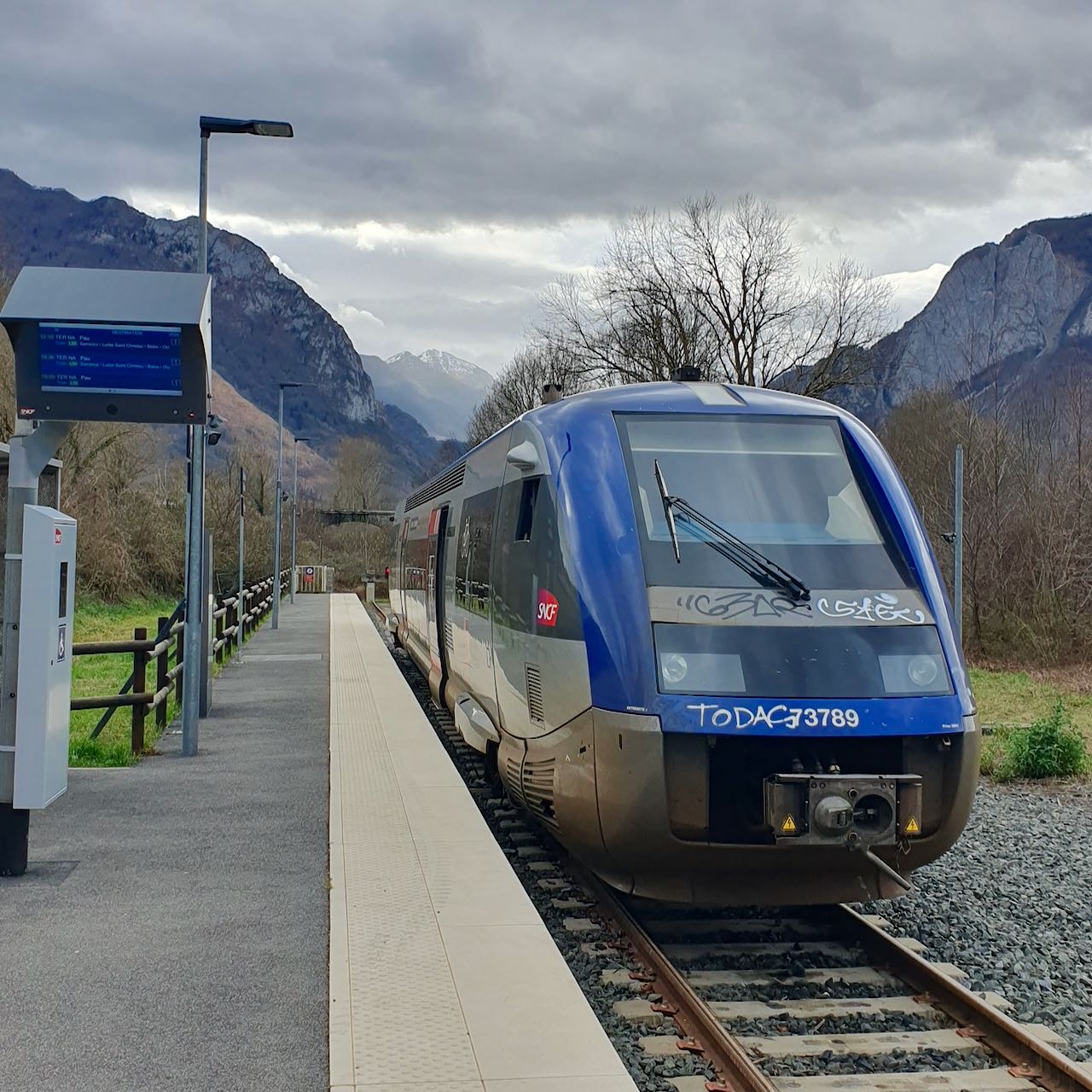
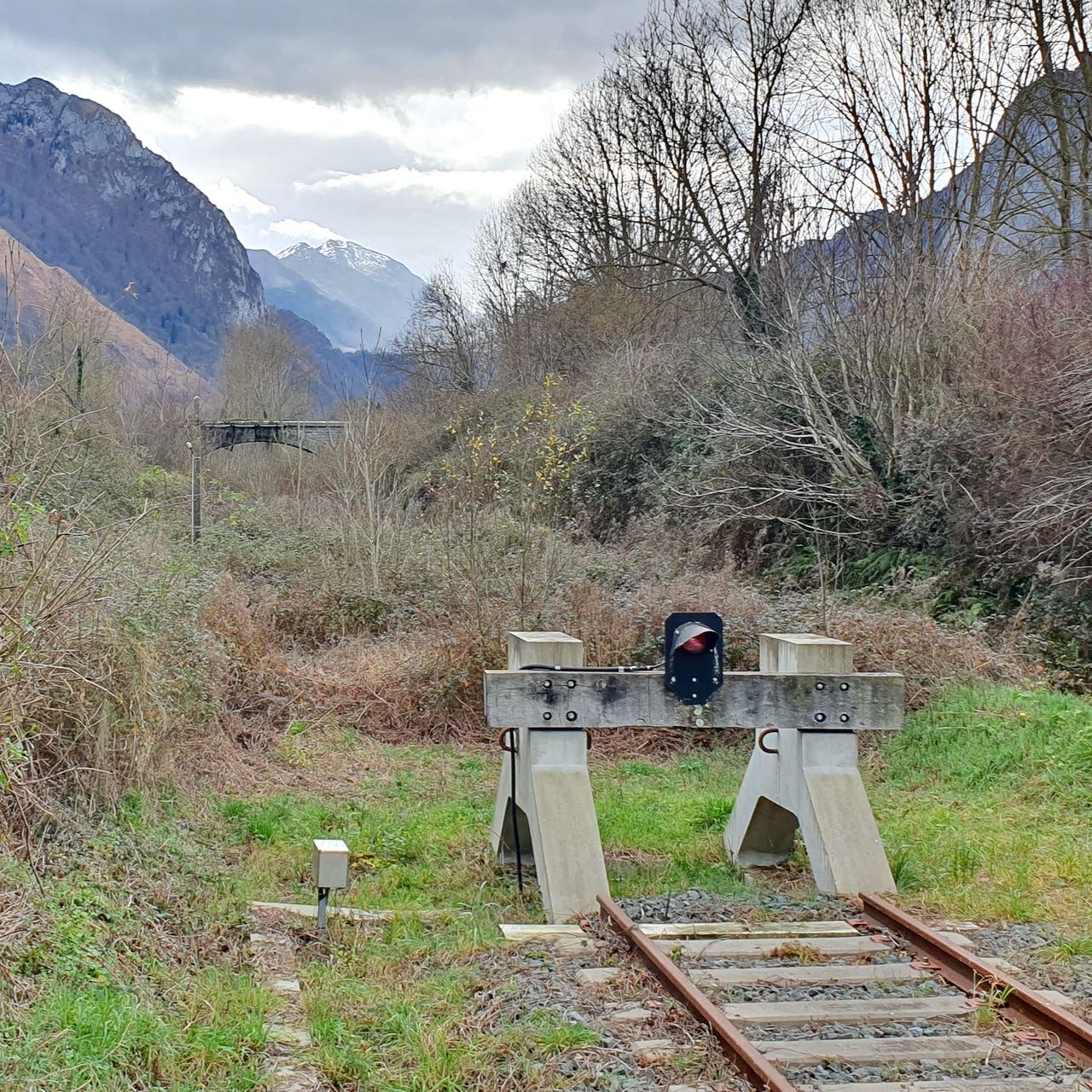
With several studies still underway, the partners estimate the cost at today’s prices to be €450 million (excluding the tunnel). Recent infrastructure work has been funded solely by Nouvelle-Aquitaine région but establishment of the cross-border freight route is supported by the EU which would contribute funding under the Connecting Europe Facility. Following consultation, the proposals will be submitted to a full public enquiry next year. Local opposition to the freight element of the project makes the outcome uncertain.
Above left. Under heavy skies at Bedous on 29th December 2022, X 73789 waits for the connecting bus from Canfranc with the 12.10 TER 867426 to Pau. Right. Spain beckons: the view southwards at Bedous shows the disused alignment heading towards Canfranc. It climbs at an average of 1 in 40, with the final ascent to Somport tunnel at 1 in 23 likely to present a significant challenge for heavy freight trains.
Above left. Under heavy skies at Bedous on 29th December 2022, X 73789 waits for the connecting bus from Canfranc with the 12.10 TER 867426 to Pau. Right. Spain beckons: the view southwards at Bedous shows the disused alignment heading towards Canfranc. It climbs at an average of 1 in 40, with the final ascent to Somport tunnel at 1 in 23 likely to present a significant challenge for heavy freight trains.
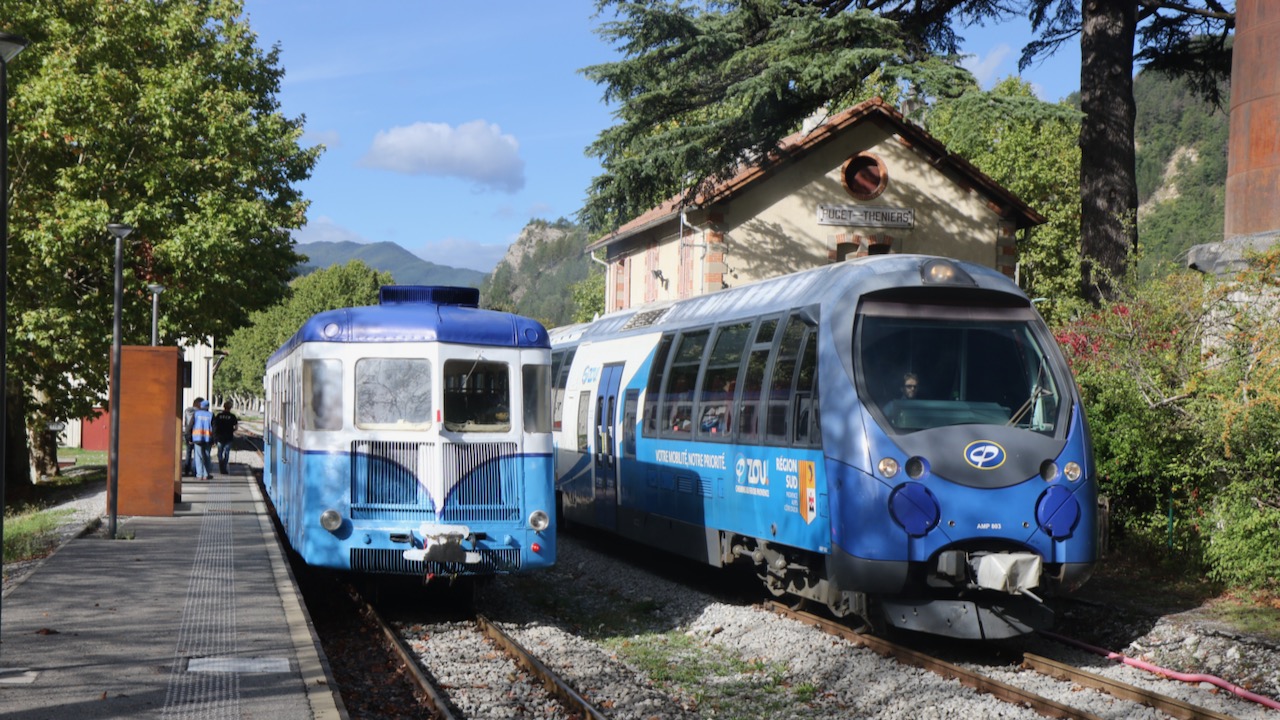

Autumn in Provence-Alpes
As anticipated in August News, on the Chemins de Fer de Provence (CP) work to repair the 1,195m Moriez Tunnel began in September. Two teams of eight men are working a double shift system 06.00 to 14.00, 14.00 to 22.00 Since the collapse of a 25m section in February 2019 trains have terminated at Saint-André-les-Alpes, with a bus connection to Digne. On the traction front CP is facing a rolling stock shortage, the line currently being operated with nine autorails: three AMP 800, five SY Class X 300 dating from the early 1970s, and the Soulé Garnéro X 351 recently returned to service having been under repair since 2021. As a result the X 300 autorails are sharing turns to Saint-André-les-Alpes with the AMP 800s, in addition to their Colomars local services, while the under-powered X 351 is confined to Nice – Colomars. Arrival of the eight Stadler hybrid autorails (diesel and battery) expected to be delivered in 2027 is eagerly awaited.
Above. On 27th September Renault ZZ 6, built in 1936 and preserved by GECP (Groupe d’Etudes pour les Chemins de fer de Provence) is seen on one of its occasional outings at Puget-Théniers, passing AMP 803 on the 09.10 Saint-André-les-Alpes – Nice. The AMP 800s are similar to the CFD Corsican AMG 800 autorails referred to above.
Below left. X 303 dating from 1972 is seen at Saint-André-les-Alpes on 27th September after arrival with the 12.20 from Nice. Shelter for passengers awaiting trains is provided by the rusty structure on the island platform! Below right. X 351 waits to leave Nice with a local service to Colomars-La Manda. With 10 stops, it is scheduled to make the journey in 26 minutes. All photos: Georges Turpin.
Above. On 27th September Renault ZZ 6, built in 1936 and preserved by GECP (Groupe d’Etudes pour les Chemins de fer de Provence) is seen on one of its occasional outings at Puget-Théniers, passing AMP 803 on the 09.10 Saint-André-les-Alpes – Nice. The AMP 800s are similar to the CFD Corsican AMG 800 autorails referred to above.
Below left. X 303 dating from 1972 is seen at Saint-André-les-Alpes on 27th September after arrival with the 12.20 from Nice. Shelter for passengers awaiting trains is provided by the rusty structure on the island platform! Below right. X 351 waits to leave Nice with a local service to Colomars-La Manda. With 10 stops, it is scheduled to make the journey in 26 minutes. All photos: Georges Turpin.
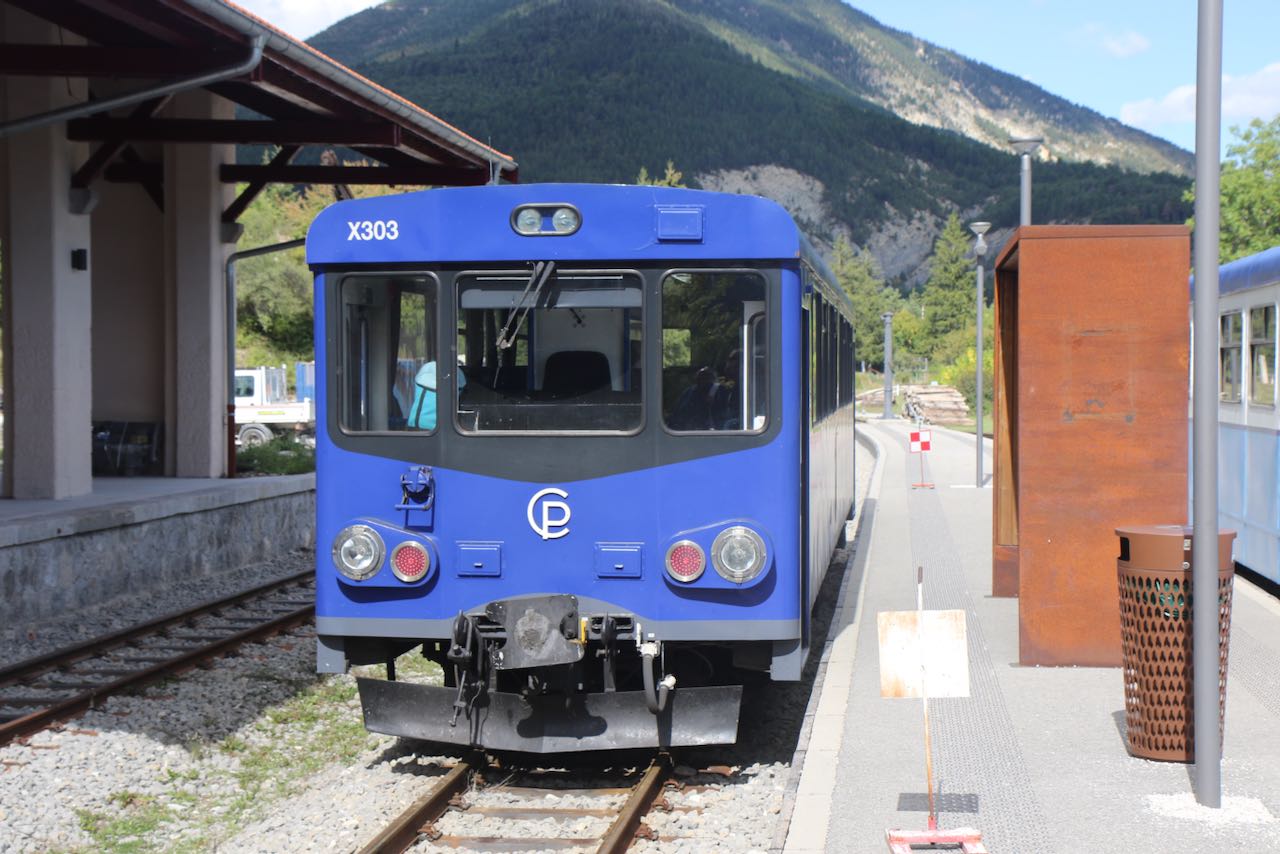
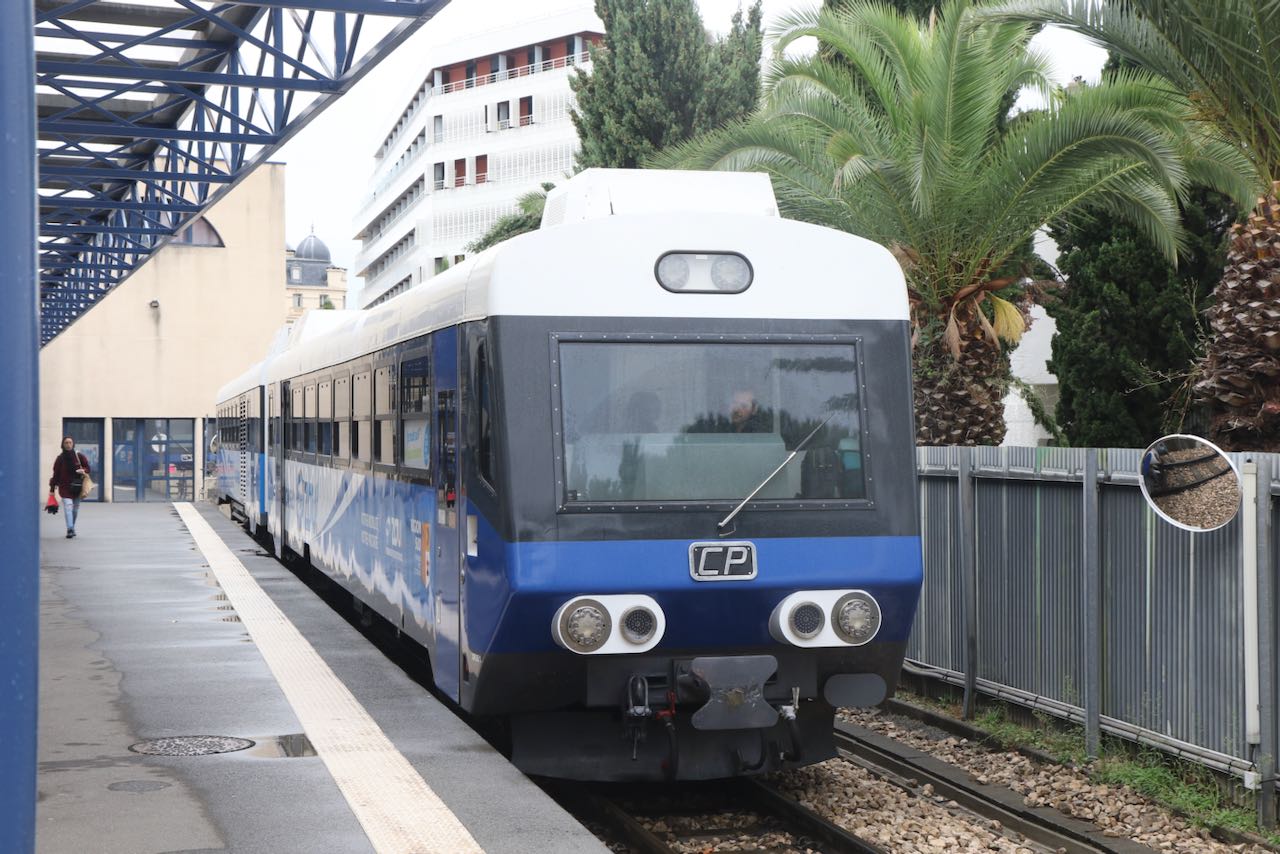
A look inside Quatres Mares
Once the main works for the overhaul or revisions of SNCF's diesel fleet, classified overhauls finished some 20 years ago at Rouen’s Quatre Mares Technicentre. Since then the works has been employed on dwindling repair work, component recovery and dismantling of withdrawn locomotives to keep remaining classmates in service. First the A1A A1A 68000/68500s and from 2010 onwards numerous diesel and electric locos and TGV power cars that had arrived in the former Sotteville triage yard. At one stage these numbered over 400, but dismantling has now been largely outsourced to commercial breakers.
Opened to the public as part of the Journées européennes du patrimoine, there was little on display, the only locomotive in the works being Hauts-de-France allocated BB 22261 still in PACA livery, seen (below left ) alongside Z 27509 (right) which was receiving a mid-life overhaul. Photos: Martin Barnsdall.

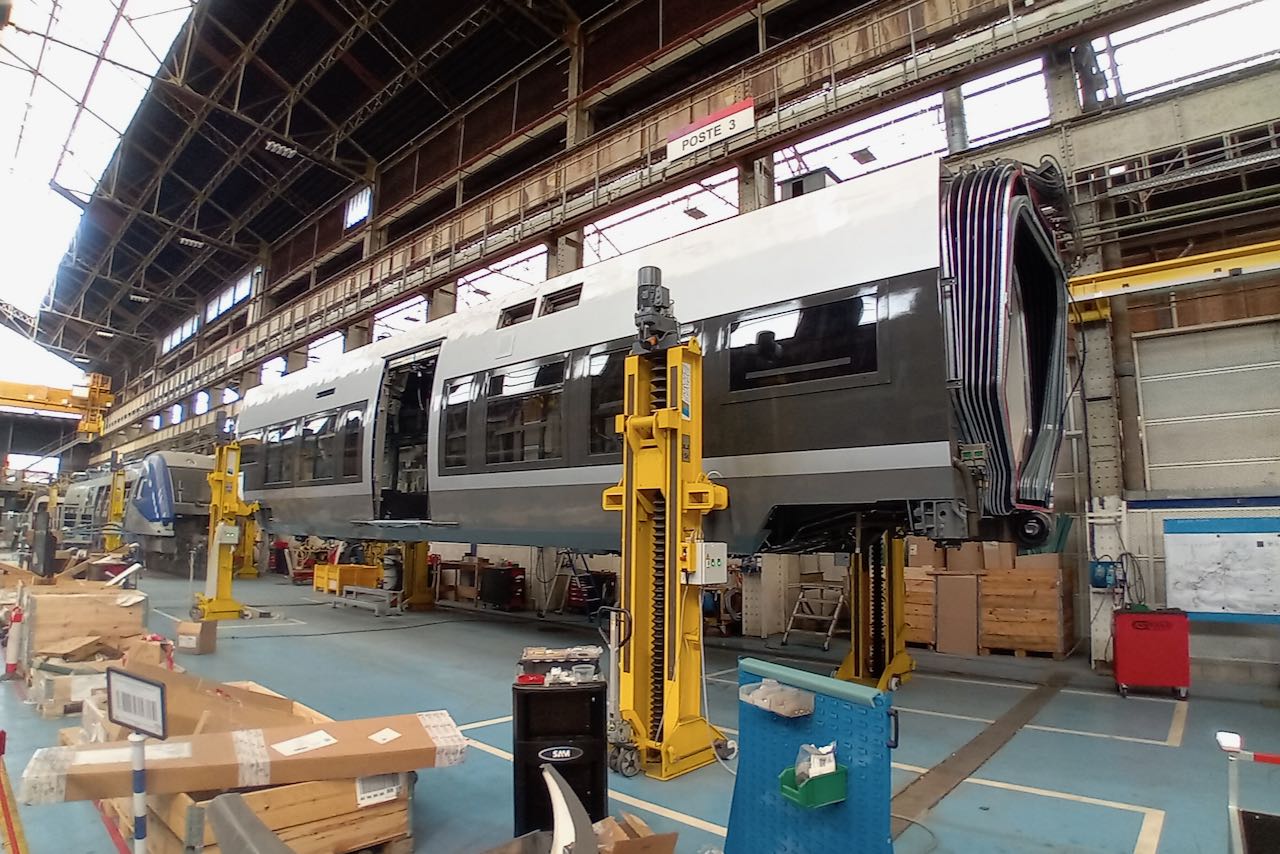
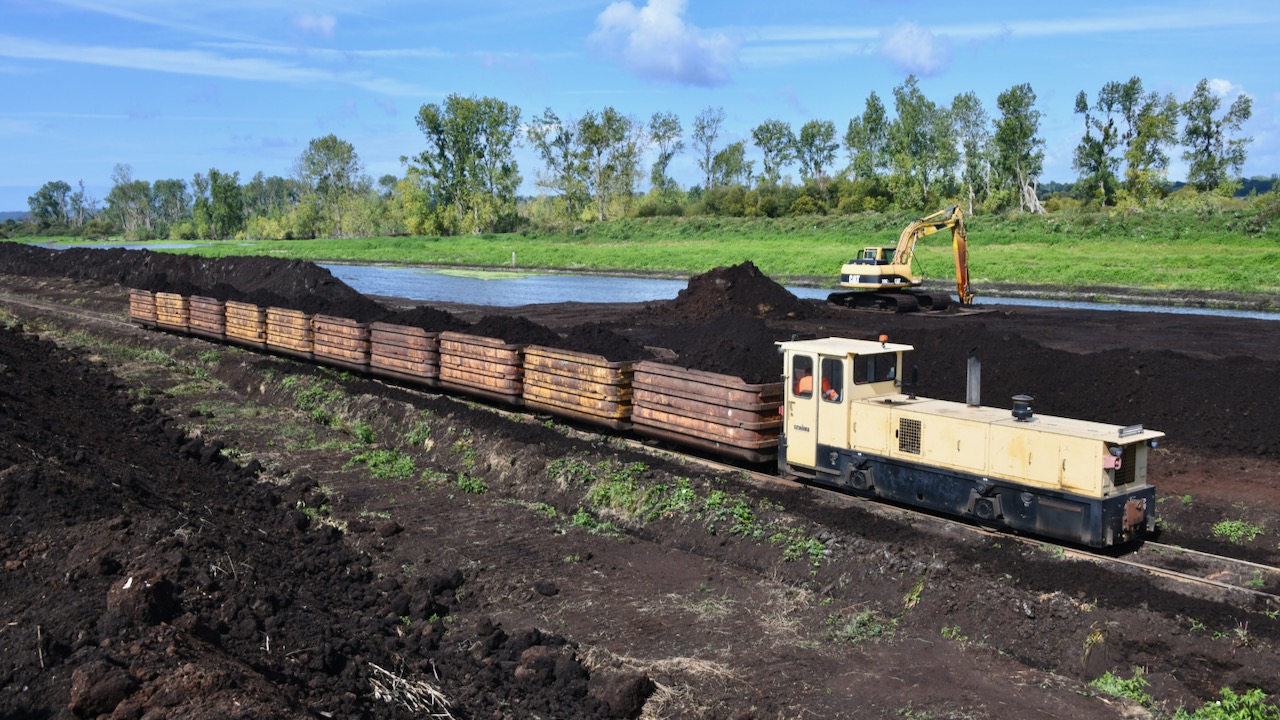
Off the beaten track
Some ten kilometres west of Carentan lies the Baupte peat bog. where for many years peat has been extracted for fuel. In 1947 a 27 km metre gauge network was laid linking the area to the Carentan - Carteret line. In 2015 authorisation was given to extract 133,500 m3 of peat per year until 2026 for use as horticultural compost. Today this is one of the last industrial narrow gauge networks in France, although only 2.5 km are in use to convey peat from the extraction site to the processing area.
There is mounting opposition to the extraction as the bog is now emitting carbon dioxide and is having an impact on water levels in surrounding areas.
Above. Seen on the 7th August, peat is waiting to be conveyed away from the extraction area to the processing site by a Schoma diesel hauling wagons formerly used in the construction of the Channel Tunnel.
Opposite. Staff transport to the extraction area is provided by an LLD locomotive towing a trailer formerly used on Charleroi's tramway system.
Photos: Didier Delattre.
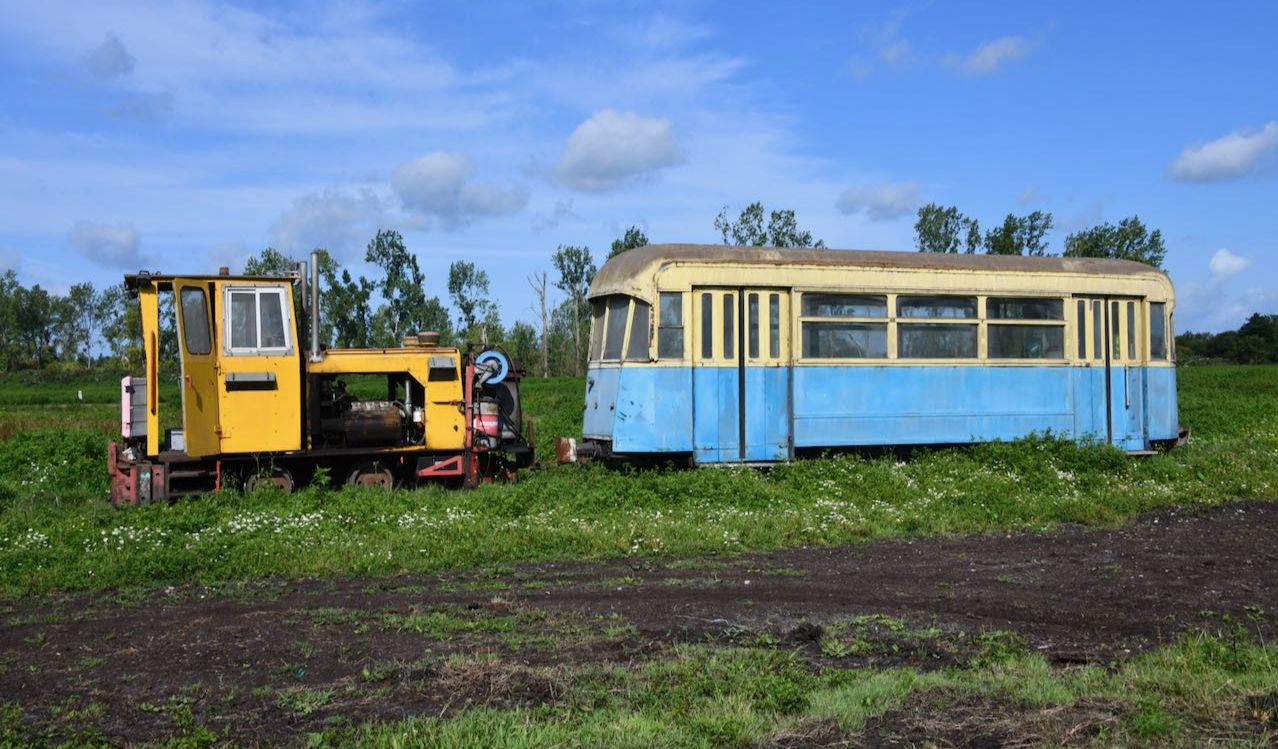
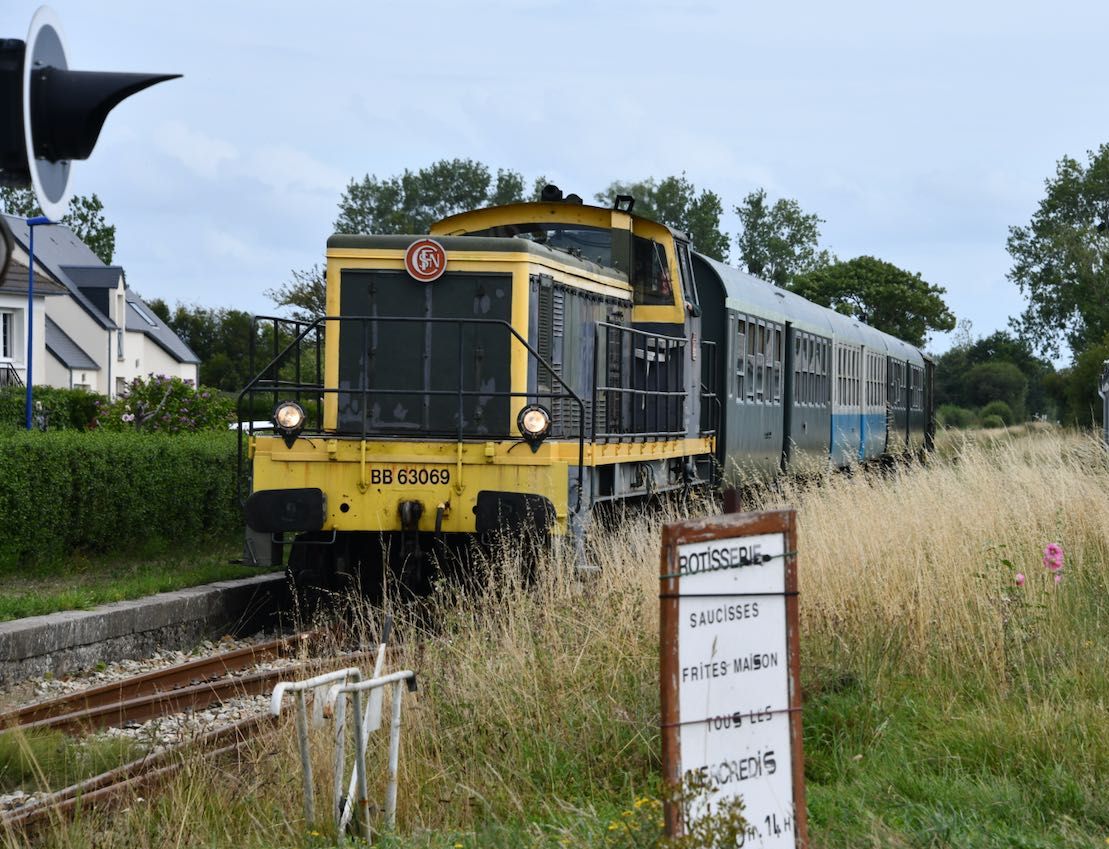
Part of the former line between Carentan and Carteret is preserved by ATCM (Association Tourisme et Chemin de fer de la Manche) who operate the Train Touristique du Cotentin between Carteret and Portbail during the summer months.
2024 was the best season on record, since operations started in 1990, with 11,473 passengers carried providing an operating surplus of €45,000. However the infrastructure dating from 1890 is in poor condition and unlikely to last beyond 2025 without major investment
Opposite. BB 63069 is seen approaching Barneville on 7th August with the afternoon service from Portbail to Carteret. Being a Wednesday sausage and frites should have been available for lunch.
Photo: Didier Delattre.
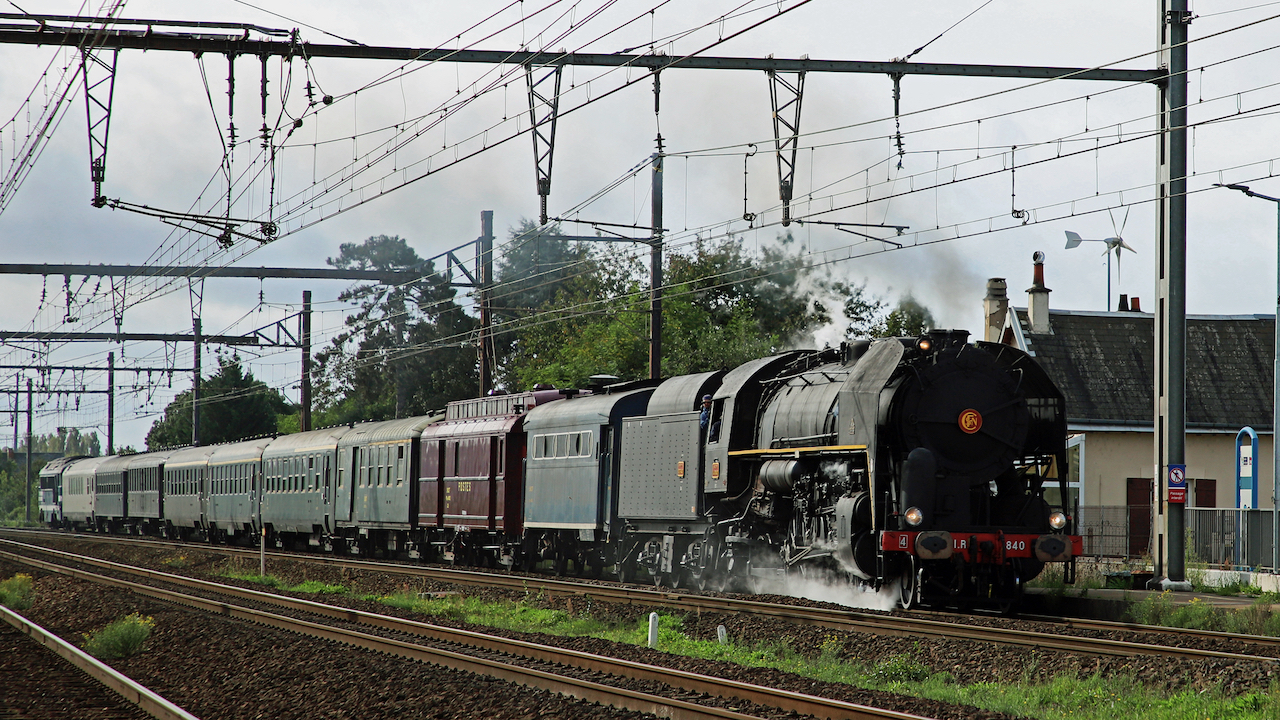
On Saturday 28th September 141 R 840 was chartered by the Ville de Cormeilles-en-Parisis for an excursion to Amiens. With A1A A1A 68540 on the rear the consist ran ECS from Les Aubrais to Le Bourget on Friday 27th. It is seen above on the Friday at Cercottes, north of Orleans. Photo: Jocelyne Bourneuf.
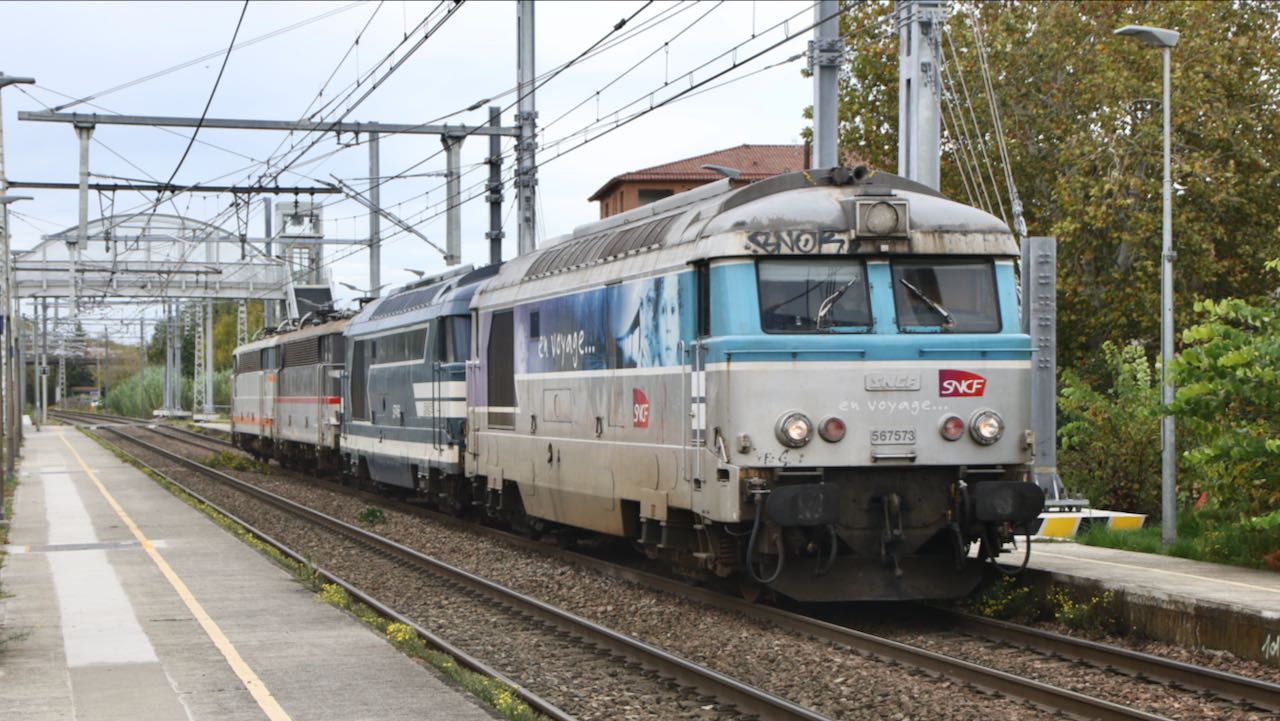
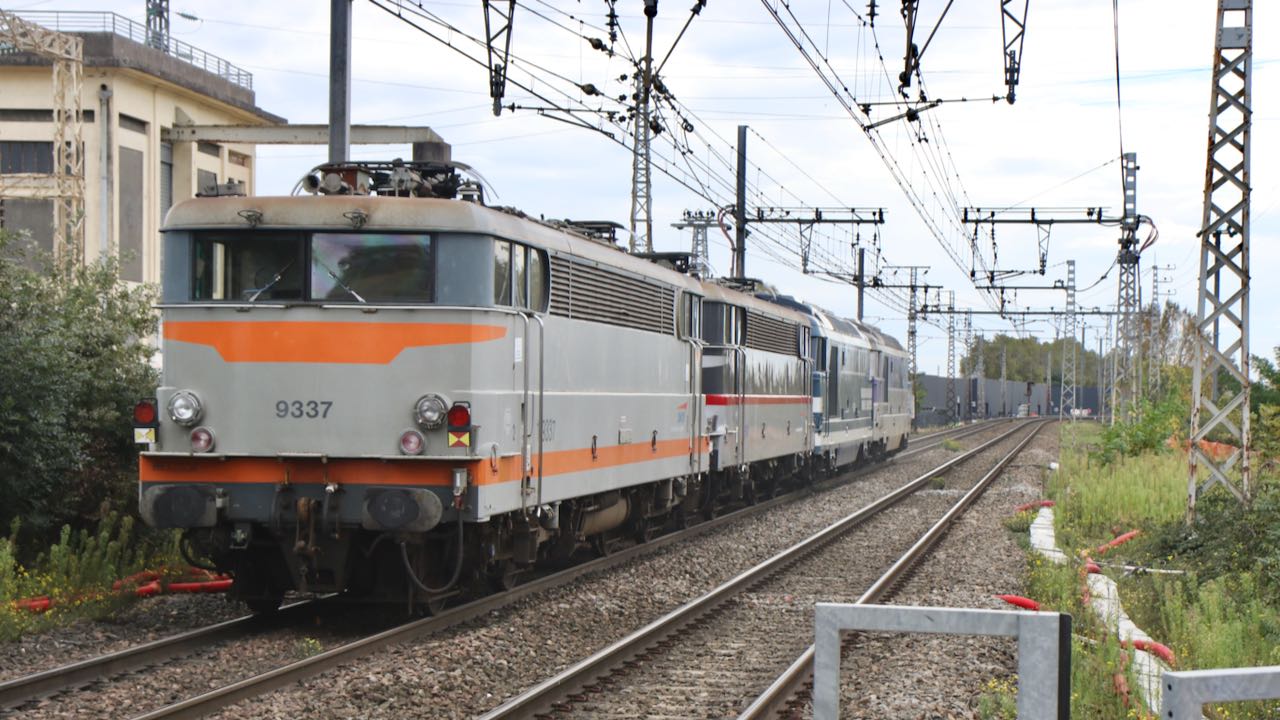
BB 9300s return home
BB 9301 and 9337 finally arrived at Toulouse on the 15th October following a two day journey from Vierzon. Here they had spent several weeks following their move from Mohon whilst arrangements for their accommodation at the Reynal Technicentre were finalised. The locomotives are currently stored alongside the depot and it is unclear whether they will be given covered accommodation. However, their situation appears to be better than Le Train Historique de Toulouse's four locomotives and rolling stock that are stored in the open at St Jory Yard. Above. Hauled by BB 67573/67546 the BB 9300s are seen above passing through St Jory following an overnight stay at Limoges. Photos: Georges Turpin.
Mountain on the move
At the beginning of October long time resident of Toulouse depot 241 P 9, became the last locomotive to leave the former Matabieu workshops before demolition begins.
241 P 9 along with Y7738, a postal vehicle and two wagons are currently parked up beside the fuelling point, now just used by Infra diesel locomotives, awaiting transfer to Carmaux. Photo: Georges Turpin.
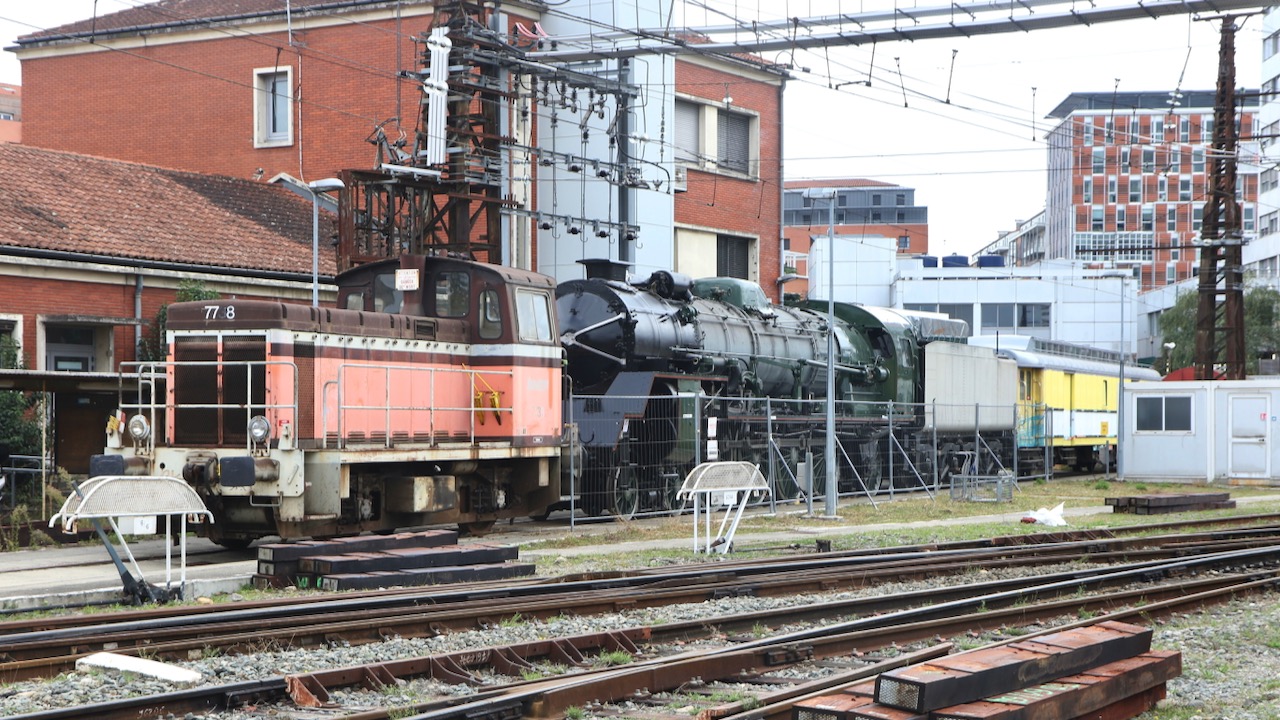
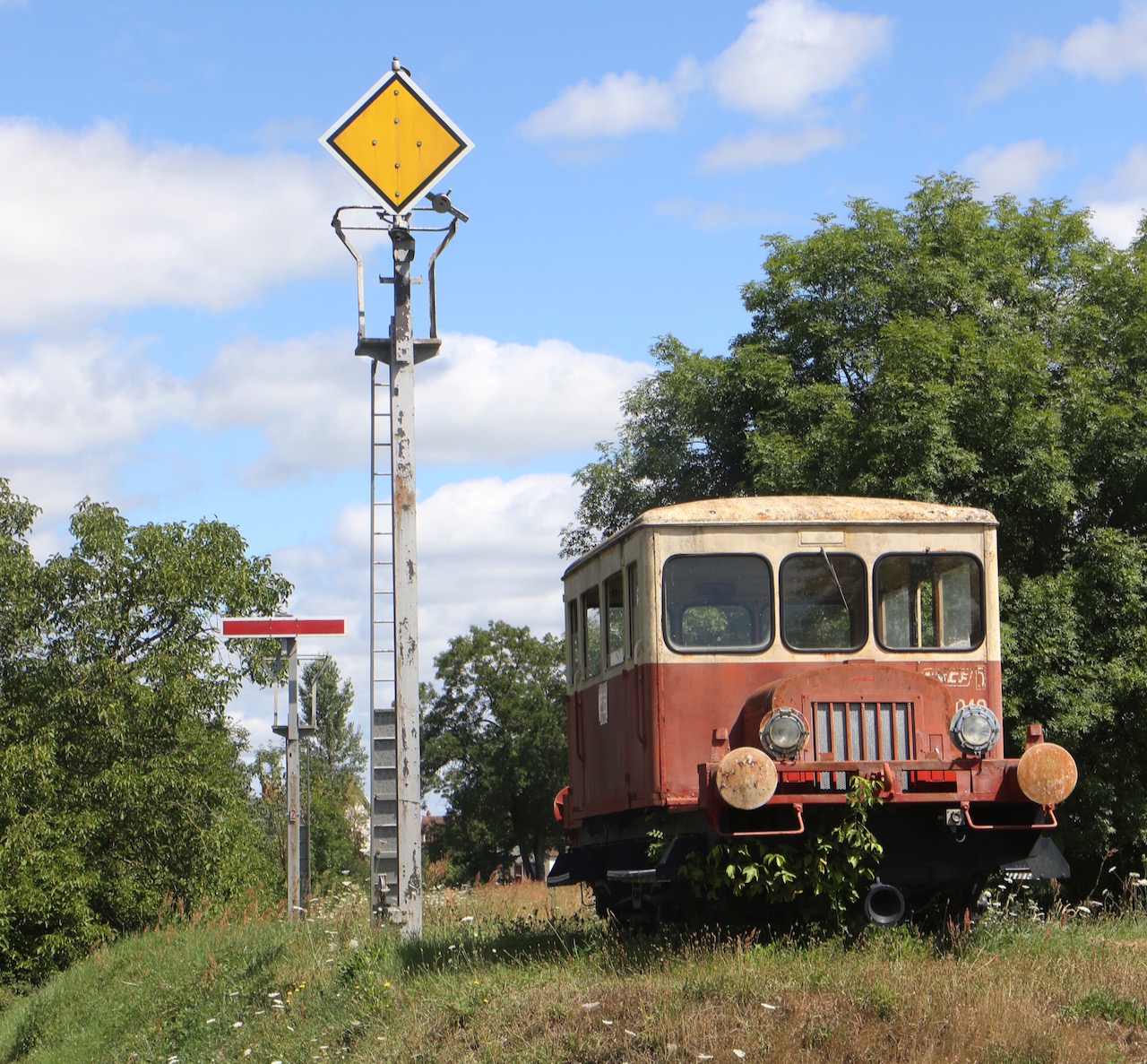
Gone, but not forgotten
Part of the line is closed to all traffic and sees rail bikes running from Mayet-d’Ecole operated by Vélorail de la Sioule. The section from Bayet to Saint-Pourçain-sur-Sioule is also due to be transformed into a voie verte resulting in the removal of the draisine and mechanical signals.
Photo: Georges Turpin.
Urban rail
NExTEO
The October issue of Railway Gazette International includes articles on progress with the NExTEO communications-based train control project and experience of upgrading Line 14 to GoA4 automation. RG’s editor has kindly made these available for members to access until 30th November by clicking on the links above.
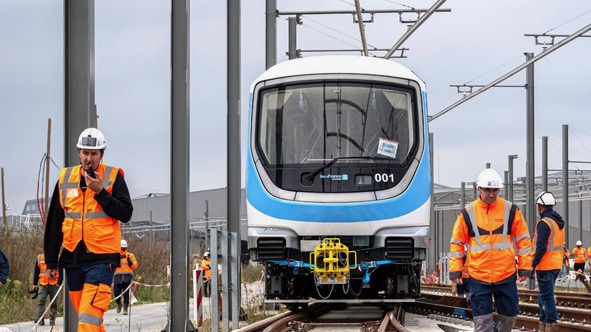
Paris GPE. The first trains for GPE Lines 16/17 were delivered to the depot at Aulnay-sous-Bois at the beginning of October. Alstom is building 25 three-car sets of the MR3V variant of the standard GPE rolling stock. Public service is expected to start in 2026. Photo: Alstom.
RATP. “During almost two years at the helm of RATP, I have been, and I continue to be, very happy” said Jean Castex on 9th October when he was confirmed as PDG with a new five-year mandate. Following an initial two-year stint during which he raised performance and guided the network through the challenges of the Olympic Games, he will now oversee opening of the first GPE lines and plans to further improve service quality by tackling the menaces of abandoned packages and staff absenteeism
ÎdeFM. Will in future order new trains direct from manufacturers rather than through RATP or SNCF, in the hope of avoiding long delays in commissioning such as have plagued Alstom’s MI20 trains for RER Line B.
Orléans. With Line A cars becoming life-expired in 2030, the Métropole is hoping for an exemption that will allow the order for new cars to be deferred until well after 2027’s elections. Replacement of the 22 cars is estimated at €100 million
ÎdeFM. Will in future order new trains direct from manufacturers rather than through RATP or SNCF, in the hope of avoiding long delays in commissioning such as have plagued Alstom’s MI20 trains for RER Line B.
Orléans. With Line A cars becoming life-expired in 2030, the Métropole is hoping for an exemption that will allow the order for new cars to be deferred until well after 2027’s elections. Replacement of the 22 cars is estimated at €100 million

Paris T1. Alstom’s new-generation Citadis X05 TW20 cars for T1 are expected to enter service from 10th December. Photo: actuParis/ES.
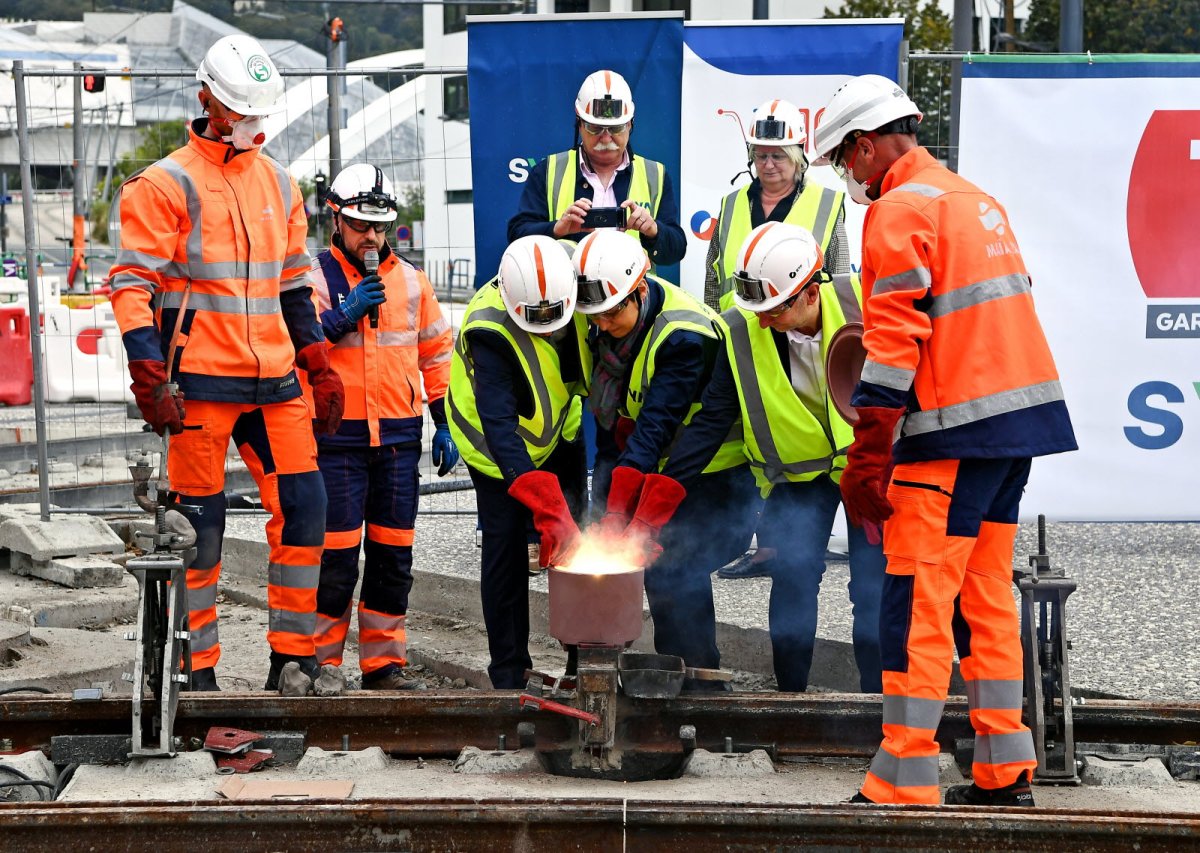
Lyon. The first rail for T10 was welded in place on 7th October at the junction of rues Tony-Garnier and Debourg. The 3.9km line is expected to open in 2026. Photo: Le Progrès/SG.
Strasbourg. From 1st October, the standard CTS €1.90 ticket permits travel also on SNCF services within the Métropole area. Valid for 1h, the ticket is only available by downloading on the CTS app.
Bordeaux. The first of 62 trams being sent to ACCM for overhaul left TBM’s Bastille depot by road for Clermont-Ferrand on 15th October. Now 20-plus years old, the network’s earliest trams will have their life-span extended from 30 to 40 years at a cost of €35 million. After 12 months’ work on the first set to test the processes involved in the 39-day renovation, a further five will follow late next year, then batches of 12 will be tackled annually through to 2029. For convenient transport by lowloader, the six-section trams are divided into two.
Photo: SudOuest/BG.
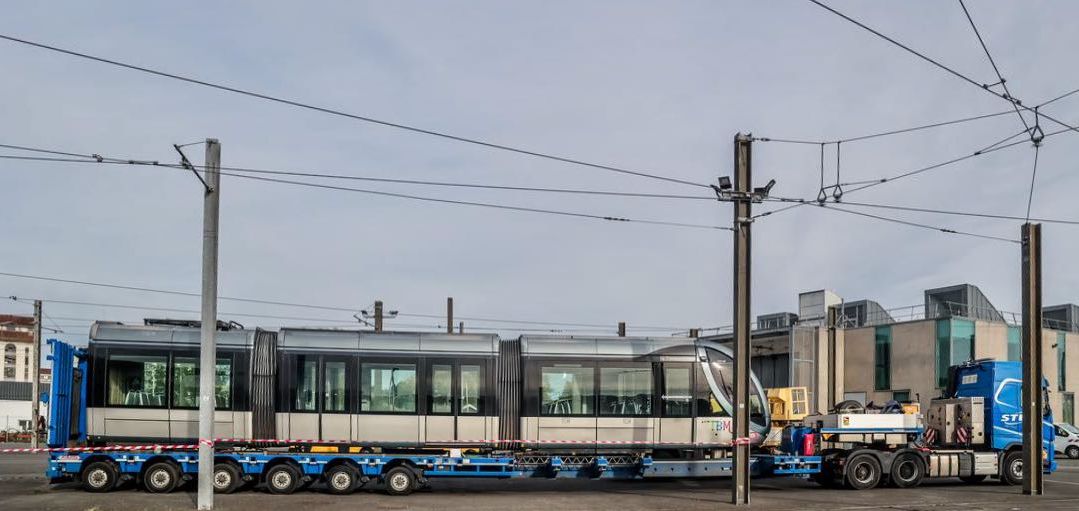
Additions to FRS Photographic Archive during October 2024
To Photographic section
- Additional images to the David Thirlwall gallery in Folder 1
- Five images of Est 241.038 at Vitry test bank in July 1933 to Jean-Hugo Filliette gallery in Folder 1
- CdF de l’ Ouest Etat General de Materiel Roulant 1 January 1887 to Folder 4 under the tab Ouest/Etat
- A new category ‘Locomotive Depot Allocations’ has been added to Folder 7 ’Miscellaneous’ in the archive
- A few colour images by Eric Russell from June 1956 of the Rotterdam Tramway Company (opposite top)
- A number of CDR articles to Folder 4 of the archive, covering BB 9001/9002, CC 6001 and BBB 6002, Le Mistral, Depot La Plaine-St Denis, Tramway Bondy à Aulnay-sous-Bois, Transports Frigorifiques, CC 40100, 2D2 ‘Waterman’ and Baldwin locomotives
Additions to the FRS public folder during October 2024
- Updated photo index for David Thirwall gallery
- Five documents from the CNAM collection, as follows:
- Origine de la Locomotive
- Deghilage 1886 - Chemins de Fer & Tramways at the Exposition in Turin 1911
- Atlas Tramways construction & exploitation 1880 - Chemin de Fer Metropolitan Paris 1901
- SNCF - “Eclairage des Signaux” - October 1957
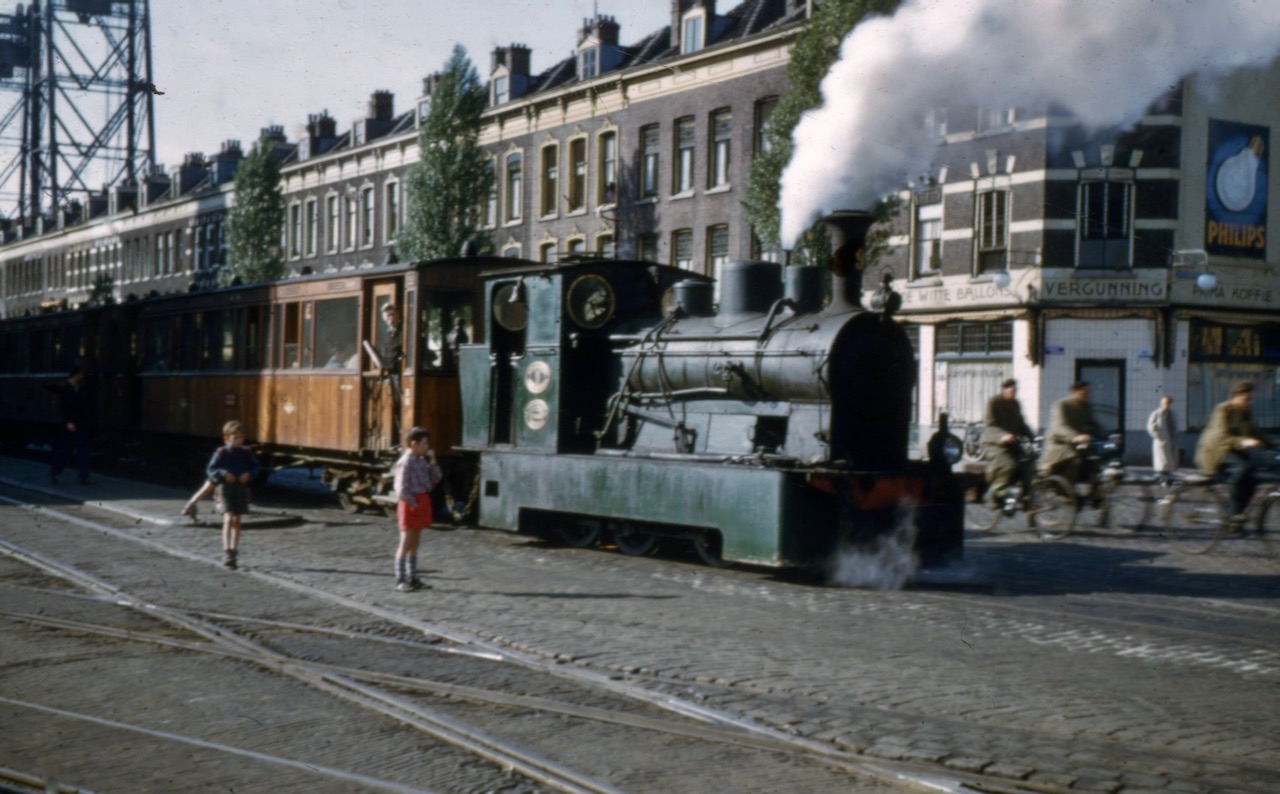
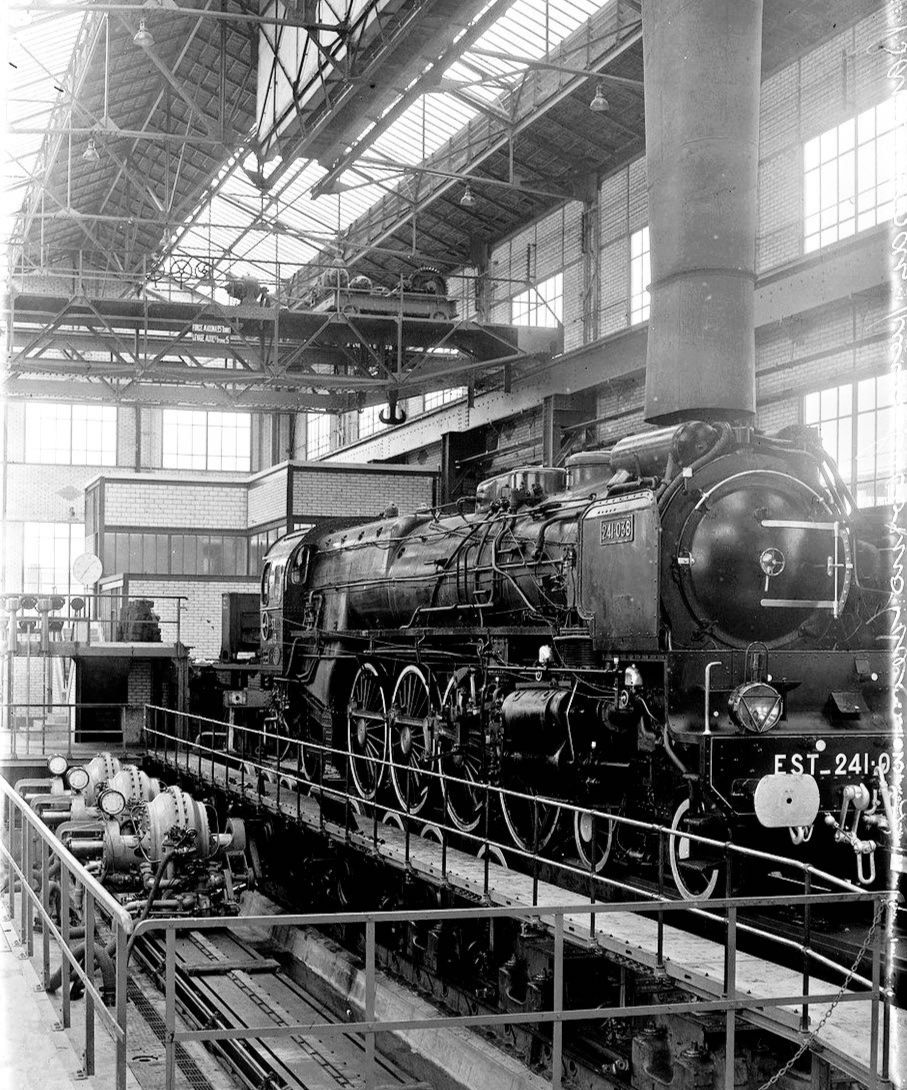
© Peter Lovell & Chris Bushell. The French Railways Society 2024. With thanks to Georges Turpin, Jocelyne Bourneuf, David Haydock, Didier Delattre, Christophe Masse, John Bamforth and Martin Barnsdall.
